cycling across japan
published 07 Dec 2023
Cycling is one of my life-long hobbies, and also my main means of staying in shape. I’m writing this post mostly for my own records but sharing it in a hope that it may be helpful or at very least interesting to someone.
ハチミツとクローバ (Honey and Clover) is one of my favourite anime series to this day. While watching it (over two decades ago!) I was quite emotionally attached to the characters and story progression. One specific arc in the story sees the main character – who has lost his direction in life – decide impulsively to cycle as far as he can without looking back.
He ends up cycling a good portion of Japan (up to the north-most point of Hokkaido), and learning much about himself.
I’ve ever since had a lifelong goal of cycling the whole of Japan. Of course, Japan is a big country – cycling the full length would be over 2,000 km!!. I’m no professionally trained cyclist – sure I’ve done a few 60-80 km rides in the past, but doing more than that distance in a day would definitely be pushing it, so that results in quite a large time sink to cover the full distance.
With my busy life of maintaining a game played by millions of players while also trying to rewrite that same game on the side, such a goal seems unattainable. Of course you could argue that I could just drop everything for a few months and make it happen.. but I suffer from very high self-expectations and drive to keep osu! going strong, so that’s just not going to happen.
So when I overheard a friend talking about their upcoming trip to Japan and they mentioned planning a cycling journey across a smaller portion of the country, I jumped on the opportunity and asked whether I could tag along – and thankfully they accepted!
The cogs started turning to plan cycling trip which ended up spanning just shy of 1,000km on paper, but had ample time allowance for both my friend’s plans to meet his “Splatoon” gaming acquaintances across the country, and my own osu! time requirements on a daily basis. It would be an effort, but one that could coexist with ongoing responsibilities.
The company
I should probably start by introducing Dunnymeister (shortened here-forth Dunny), my good friend (and later on, coworker for some time before osu! took off). He’s a Taiko no Tatsujin connoisseur, great chef and even brews his own beer.
The bikes
In recent years, I’ve been using an e-bike to get around. But I wasn’t about to take an e-bike on such a trip – not only would charging be a hassle (if it made it through a day in the first place), but it would just be rude to be riding an e-bike alongside Dunny on a non-powered bicycle. And honestly it would just make the whole trip less of a challenge.
Dunny originally planned to bring his bike across from Australia with him, but the logistics of this (and registration requirements in Japan) made him look in the direction of purchasing a bike here instead.
It ended up that we both started looking into Trek bicycles and eventually settled on some mid-range models. Aluminium body with hydraulic brakes and drop handles were the criteria we had in mind.
I went with a gravel model for thicker tyres and a more relaxed riding position. While I do plan to mostly stick to the tarmac, I am more used to riding on tyres that look like they aren’t going to completely lose traction at the sight of some non-road terrain.
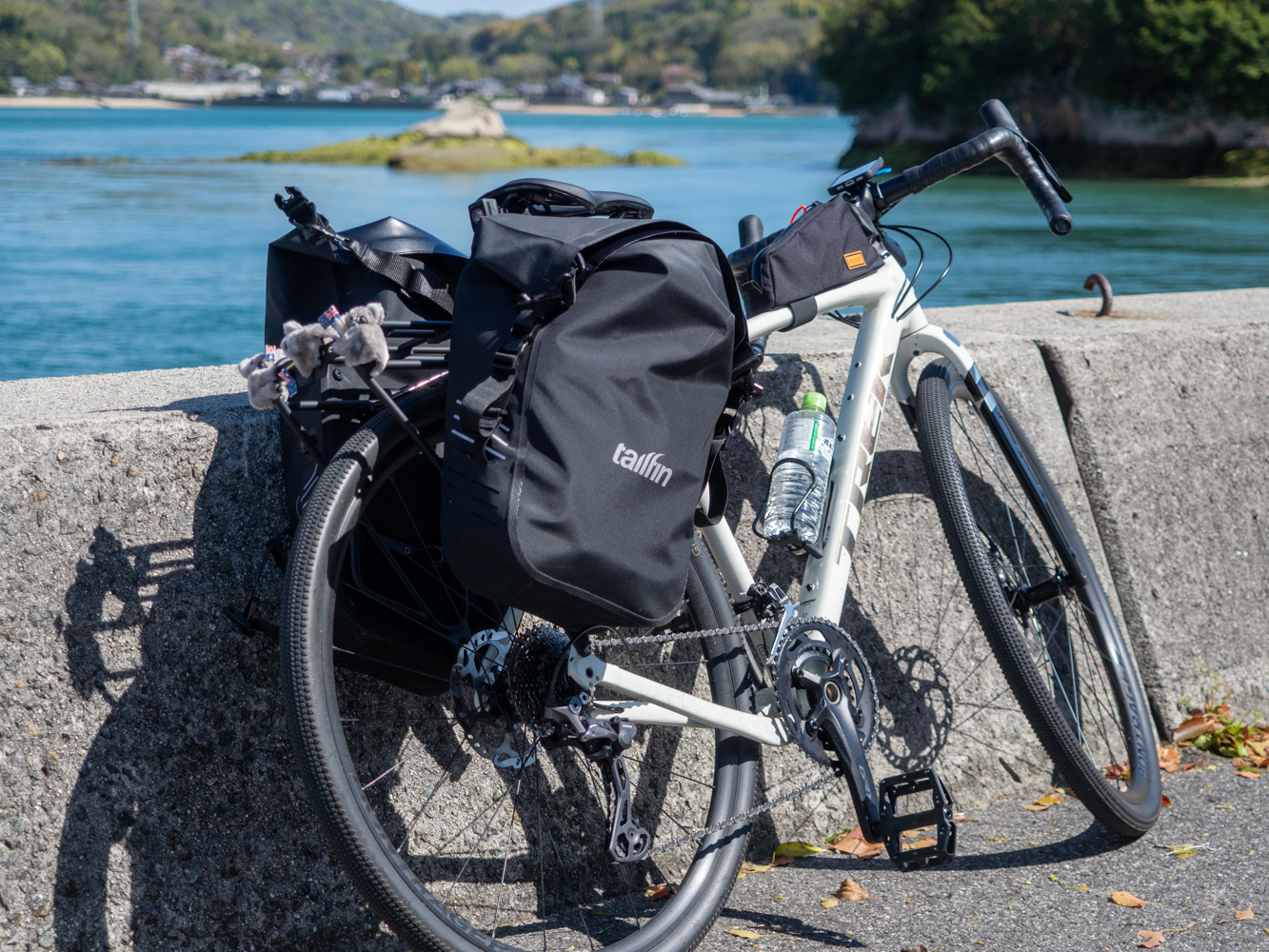
Dunny went for the road model, which left us with an 8mm difference in tyres (32mm vs 40mm). Probably making life slightly harder for me due to lower efficiency, but a bit of quick research says there should only be around a 10% difference.
For reference, the models were Trek Checkpoint ALR5 and Trek Domane AL4. They served us well (and will continue to do so into the distant future, no doubt).

The assembly
Dunny had already chosen various cycling routes he wanted to challenge. But these were spread across half the country, and cycling between each of the courses would take way too much time. And, well, this was supposed to be a casual sightseeing trip, not a gruelling endurance ride.
The decision was made to use Japan’s amazing train network to get between some of the more distant areas we wanted to cycle. The caveat being that bicycles are generally not allowed on Japanese trains (with one recent exception!), which means we would have to get used to what is known as Rinko (輪行) – the process of disassembling your bike and putting it in a bag, making sure no bike parts are visibly protruding.
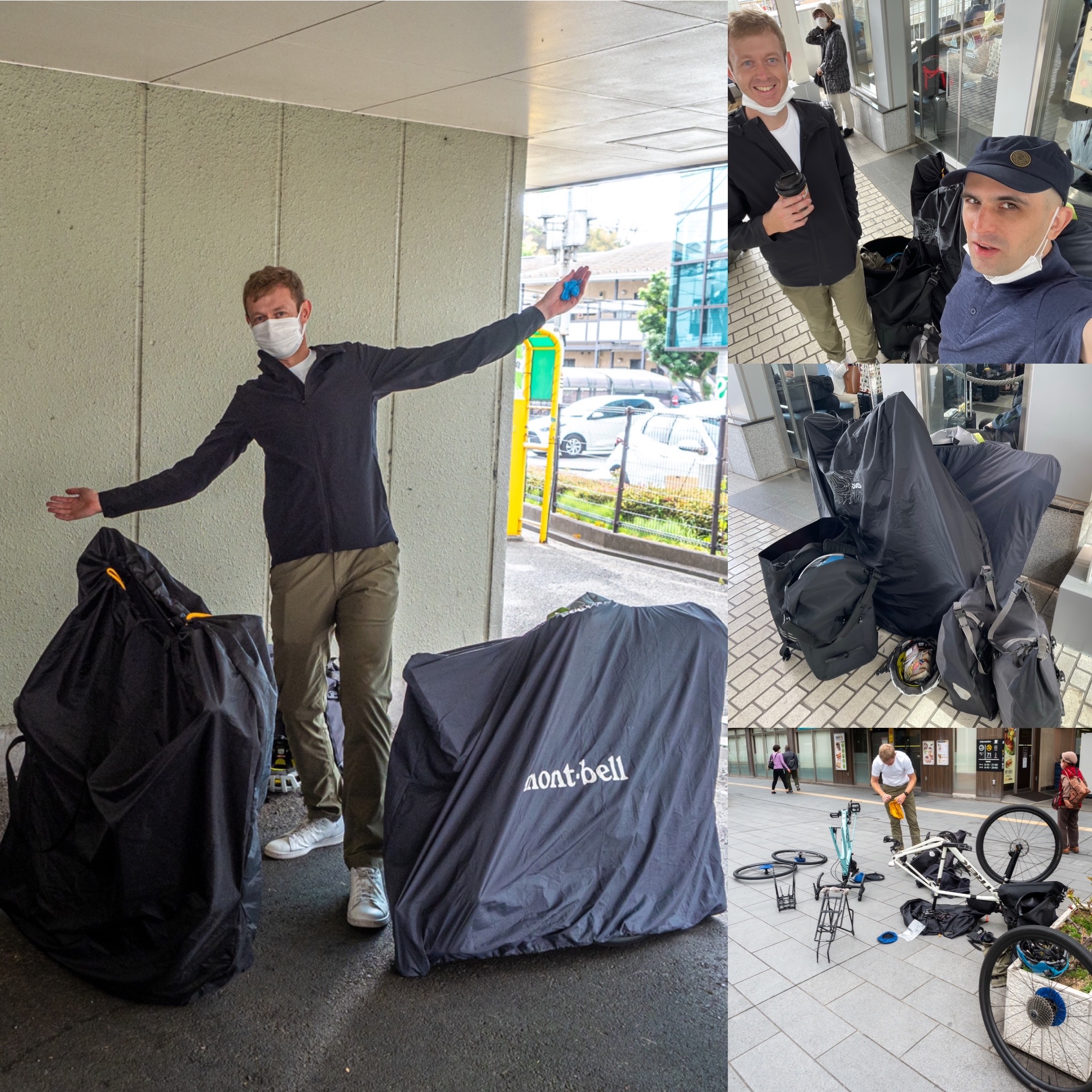
The gear
Apart from figuring out the general routes, the majority of planning was figuring out what we needed to bring along. Or rather, what we didn’t need to bring. We were very aware that cutting down on weight would be in our best interest, so taking the bare minimum was our goal.
Of course, it’s a delicate balancing act. What if we don’t have enough clothes to get to the next hotel with washing facilities? What if we run into mechanical issues, punctures or otherwise? And the hardest question of all: what is the minimum amount of tech we can get away with to both be productive and live comfortably?
We settled on dual pannier setups, along with some small frame bags with maintenance tools and for quick access food and drinks. Our pannier bags ended up weighing in at ~10 kg per person, so about the same weight as our bikes. This was basically our upper limit in terms of goal weight.
For me, this is what I decided on:
- 2 x Tailfin Ultra Durable Pannier Bag
- Restrap Top Tube Bag
- Restrap Tool Roll
- Rinko bag (DAVOS G-110)
- Pump (LEZYNE POCKET DRIVE PRO)
- Helmet (OGK Kabuto “IZANAGI”)
- Spare tube and tyre levers (Trek tube / Panaracer levers)
- Bike alarm (KNOG Scout)
- Clothes for 3-4 days (including some non-cycling clothes for when we went out with friends along the way). Included some wet weather gear.
- Toiletries
- Mobile battery (80 Wh)
- Action camera (DJI Pocket 2)
- Mirrorless Camera (Olympus OM-D E-M1 MarkII, M.ZUIKO ED 12-40mmF2.8PRO, 3 batteries)
- Bluetooth speaker (JBL CLIP 4 Bluetooth)
- Laptop (MacBook Air M2)
The journey
Shimanami Kaido (しまなみ海道)
Possibly the most famous cycling route in Japan, spanning the islands of Shikoku (四国), this was the starting point of our journey. We spent the first day getting as close to one end of the route by Shinkansen as we could.
It was a bit of a rough start after discovering our train booking didn’t have the “oversize baggage” area correctly reserved. This surprised me as I was very careful to select the option when booking in the app. It was only later in the trip where I discovered an iOS level UX issue which can cause a change in dropdown settings to not register correctly if you confirm the action too fast:
Regardless, the train crew handled the situation so courteously and without any signs of distress, allowing us to place our bikes in between train cars. I continue to have unwavering faith in JR as a company. But we did really want to get off the trains and onto the bikes!
We made the decision to cycle from the Shinkansen station rather than catching a second local train – after our first train ride we were already tired of carrying our bikes on our shoulders and jumped at the opportunity to skip one train transfer. Getting off at Fukuyama (福山) station, we were full of energy with the route’s starting point of Onomichi (尾道) in our sights.
This was the first time we discovered just how much there is to see, even when not using a great deal of thought in the route. Even as we were racing an incoming storm, we couldn’t help but stop to take in the sakura (cherry blossom) in full-blossom; an amazing temple; a small corner shop selling the local range of citrus fruits and as we approached our destination, the scenery along the short of the nearby river.

Onomichi was a very cyclist friendly place to be, with the hotel we chose having dedicated road bike parking and facilities. This of course makes sense, as it is the starting (or ending) point of the route.
We ended the day with some local ramen. A highlight was a Japanese salaryman walking past and exclaiming “Ooh, he got a mega sized beer!” (おお、メガジョッキだ!) at Dunny’s mega sized beer!
🛌 Onomichi Kokusai Hotel
🍝 Onomichi Ramen Aji Men
And so we set off on the Shimanami route.
The first day started with getting our bearings - figuring out how to get on to the route (up a windy road, over a bridge we weren’t sure we were even allowed to ride) and subsequently how to remain on the route. The general idea is “follow the blue line on the road”, but we soon learned that this line can arbitrarily stop in places you wish it didn’t.
As a note, the normal way of getting on the route from Onomichi is to take a short ferry trip, which I’d probably recommend as the more scenic and straightforward route.

We were taking the route on a bit of an off-season, so we mostly had the roads to ourselves. There were quite a few roadside stops along the way, including locals selling their produce (and giving out free samples of course!).
Other cyclists were very friendly, and the bikes they were riding ranged from aero road bikes to fat-tyre.. contraptions. We stopped at a convenience store (aka Conbini) for refreshments and watched over as a group of 10 or so cyclists riding together were figuring how to repair a tubeless puncture – seems we weren’t the only ones with little experience with tubeless tyres!
Our first day was quite a long one, as we stormed through the first three of the route’s bridge crossings in order to reach one of the only accommodations we could find with vacancies on this day. I need to mention here that it was our smart idea to wing accommodation for this part of the journey (surely there would be plenty right?!).

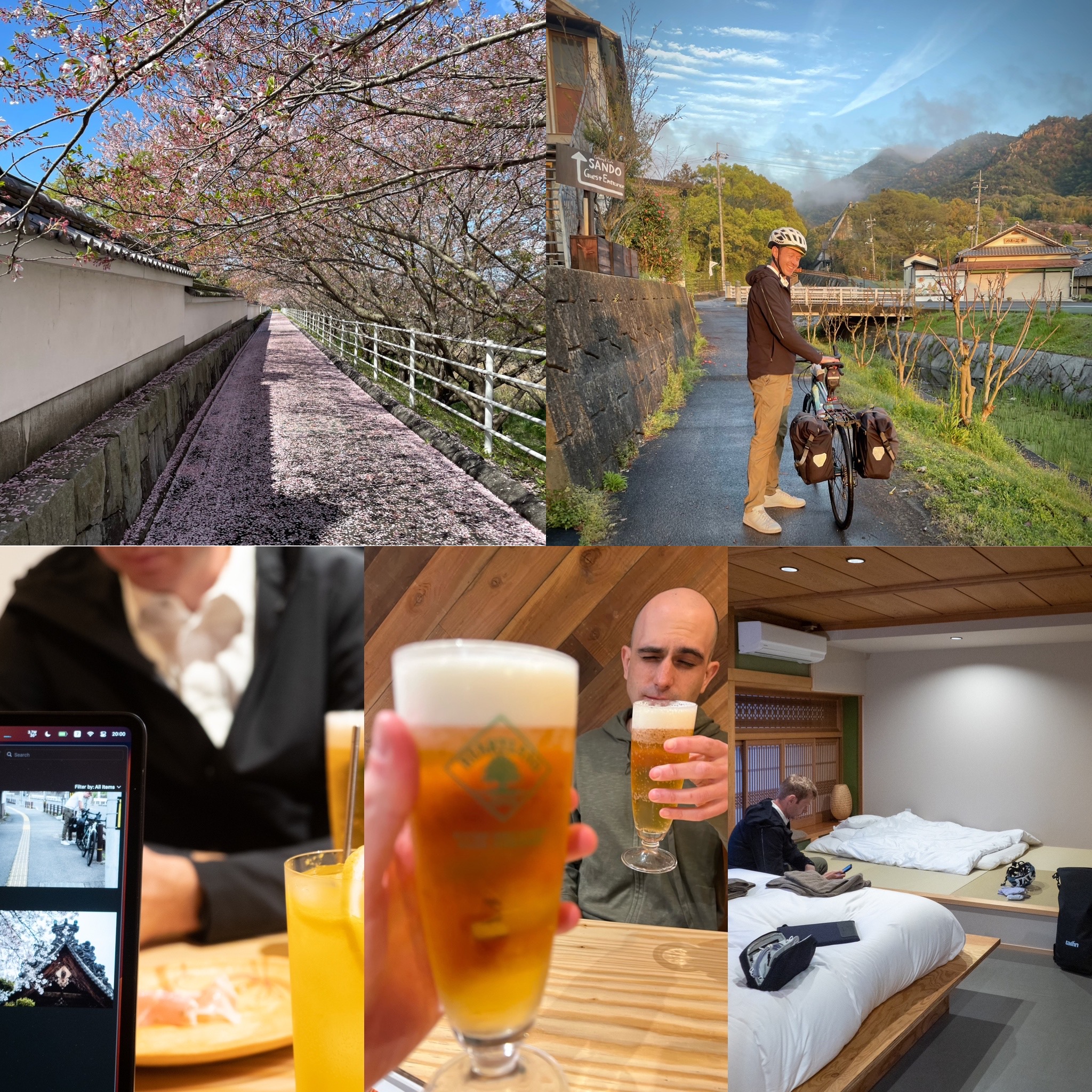
The beds we managed to secure were at a very cosy cafe-hostel combination which served some great beer, pizza, fish and chips and sour drinks mixed with the local citrus fruits. We consumed it all. The hostel owner (and chef for the night) may have forgotten our orders more than once, but the amazing food, drinks and vibe more than made up for it!
🛌 Coliving & Cafe SANDO
🍝 Coliving & Cafe SANDO
Our next morning started with the goal of finding somewhere that was open for breakfast. We found nowhere, so settled on a conbini breakfast. On the way out of the town, we did a final ride around to check out the area and came across a small storefront for a local winery. Thinking they might also have some kind of beer or snacks we headed in. The lady there informed us that they didn’t really have much other than some bottles of wine for sale, but passed on the amazing news that there was a wine and beer event on only today, and only 6 km away. Even better, it was basically on our route out of the area. How could we resist such an amazing temptation?!
As it turns out the event was being run at a local cycling organisation’s camping grounds. We greeted the staff from the same winery that made us aware of the event, and then went on to definitely not drink every wine and beer on offering (a total of three different stalls)… because we are responsible cyclists and that would take us over the legal blood-alcohol limit of 0.00% in Japan.
We also consumed some very awesome jerk chicken. The guy making it had a great selection of hot sauces.
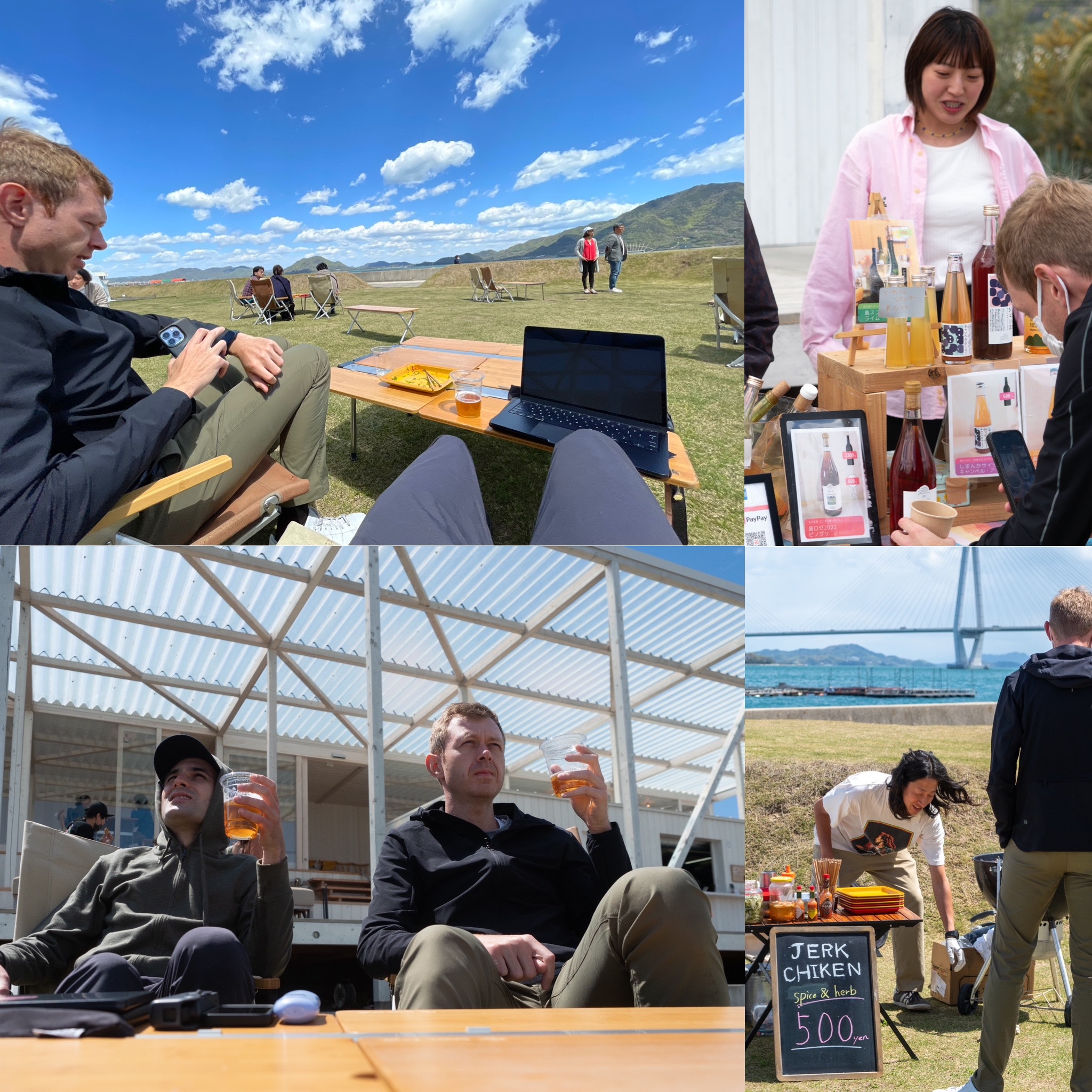
We then set off – in very high spirits – for our next destination of Imabari, a city famous for locally produce towels. The towels are actually world renowned for their high quality, to the point the city has an official certification process which companies can apply for in order to don the coveted Imabari branding.
After arriving, we managed to find a hotel that had rooms with built-in bike stands on the walls, very cool! All these special rooms were taken unfortunately, but as usual were met with exemplary customer service – something referred to over here as “Omote-nashi” (おもてなし) – pulled through and the front desk setup some bicycle stands in the lobby especially for us. Well, for our bikes.
We then went on a walk to find a small family-run eatery (Shigematsu Hanten) that is said to server a rice-bowl covered in eggs to die for. Not the fanciest of places to eat, but the food was as amazing as expected!
🛌 JR CLEMENT INN IMABARI
🍝 重松飯店
Imabari was one of the “cycling stations” on this route, so in the morning we made use of their pumping and washing facilities to give our bikes a bit of a clean-up after riding through semi-wet conditions the last couple of days.
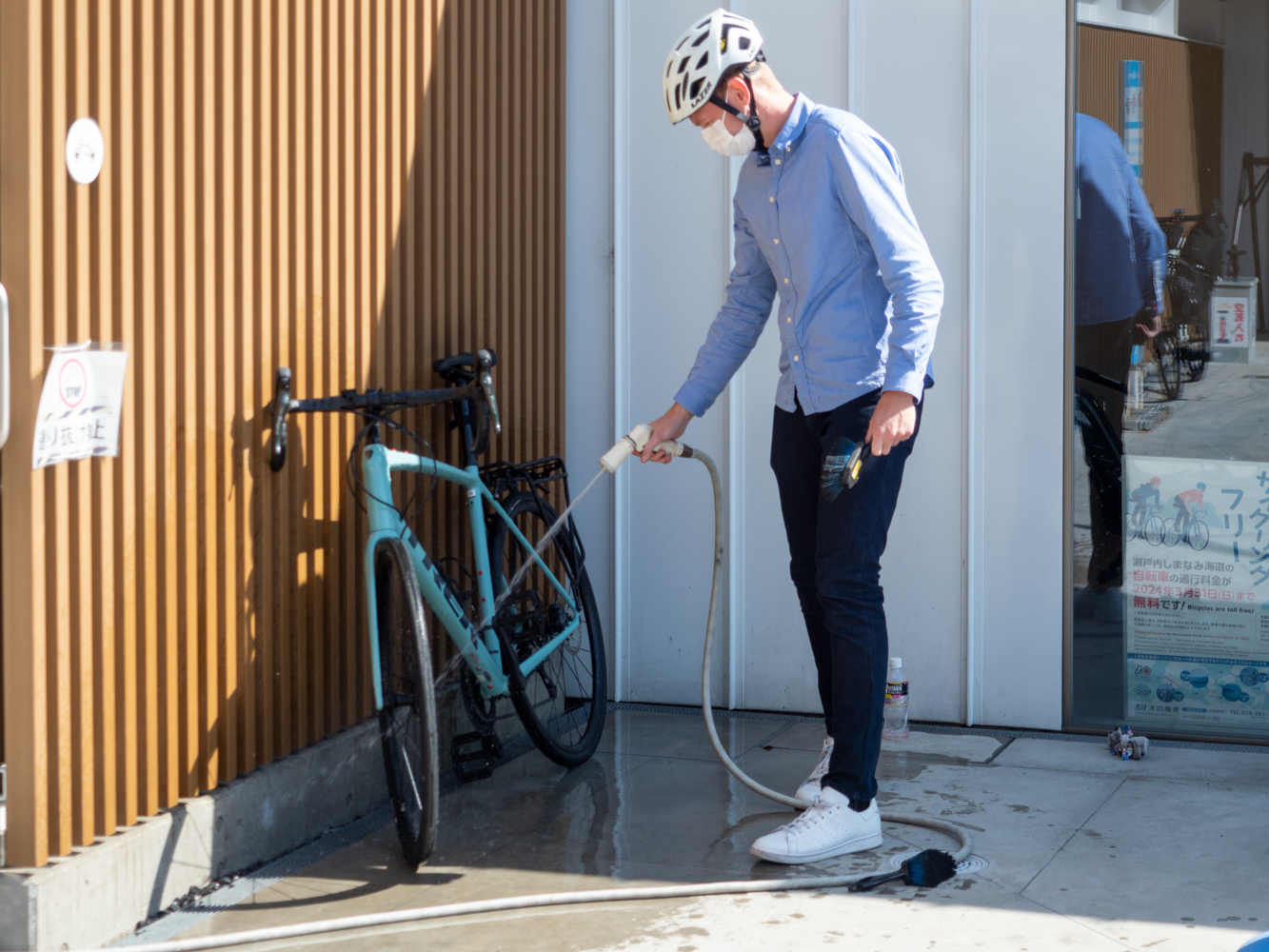
This was the first time I was able to use a proper tyre pump and check my tyre pressure. I was a bit suspicious as I was struggling towards the end of the previous day.. but very surprised that it was around 22 psi!! For efficiency I really shouldn’t have been running below 30. I pumped them back up to 35 psi and the difference was night and day!
After a maccas breakfast we had been craving, and a brief detour through a “Hard Off” – a huge second-hand electronics store that could literally hold our attention for hours – we set off for another day on the road.
We stopped by at a large roadside rest area which seemed to have a weird cosplay culture going on (of the military variety)!
The day before when checking in at the hostel, the owner made small talk with us and it went something like “Ah, you’re cycling the Shimanami route! I guess you’re heading to Dougo next?” to which we responded with a puzzled look.
Upon a bit of quick research, Dougo Onsen is a very historic onsen area in Matsuyama which seems to be a must-stop. So of course, we planned a detour, lest we disrespect the Japanese cycling pilgrimage!
Dougo onsen was everything we imagined it to be – a small town-like area with ice cream, beer and many people looking to take a bath. The main onsen building had a waiting list of around 2 hours, but the staff informed us there was a second building that recently opened, with the same “quality” of water (as in it comes from the same fabled mountain source) but no wait time.
We didn’t really have two hours to spare as we wanted some time to make the remaining distance to our next lodging before night hit, so opted to locate the second, much more colourful but less ancient-looking onsen.
And oh boy was it worth it. There’s nothing quite like hitting a hot spring and taking a moment to relax and reflect on the journey thus-far before continuing on.

Our accommodation tonight was an Airbnb on the coastline, in the middle of nowhere. It was a huge looking house that most definitely was inherited or bought for the specific purpose of renting it out.
They mentioned in the description that it was possible to use a disposable BBQ set in the garden area, so we made a stop along the way at a supermarket to buy enough vegetables and meat to replenish our energy.
Oh, and beer.

The ride along the coast during golden hour and leading into sunset was absolutely magnificent. Then the sun dropped and the chilly evening air hit, bringing us to our senses. This was definitely not outdoor barbecue weather.
We arrived at the accommodation, with the last 5 minutes of the ride being up an insanely steep hill to get there. We were already worn out and this is the last thing we needed, but at least it warmed us up a bit! On arriving, the sight of this amazing traditional Japanese house with its own rock garden and sea views made the effort probably worth it.
The barbecue happened. We didn’t really bring much cold weather clothing as we were trying to travel light, so layered on as many layers as we could to make this evening work. It was pretty great but also pretty cold. Without beer and good company it likely wouldn’t have been anywhere near as bearable.

🛌 Entire home in Iyo
🍝 BBQです
Final day of Shimanami, and we were on the clock, with a ferry booked and still 34 km to travel. We set out as early as we could and powered through.
This final segment was quite memorable for the four tunnels that we had to traverse – up to 1 km each. You could tell when one was coming up as the elevation graph on our GPS went from being bumpy mountainous terrain to suddenly completely straight and flat.
In the tunnels we could pick up some great speed, but we were also riding alongside cars and trucks in a confined space. And tunnel acoustics mean you get hit with the car noise ten-fold as it arrives from every direction, echoing off all the walls.
We made the ferry with around 45 minutes to spare and prepared for boarding alongside some bikers. It was a pretty great experience seeing the ferry workers securing our bikes to dedicated road bike mounts, and then leaving them for the main cabin.
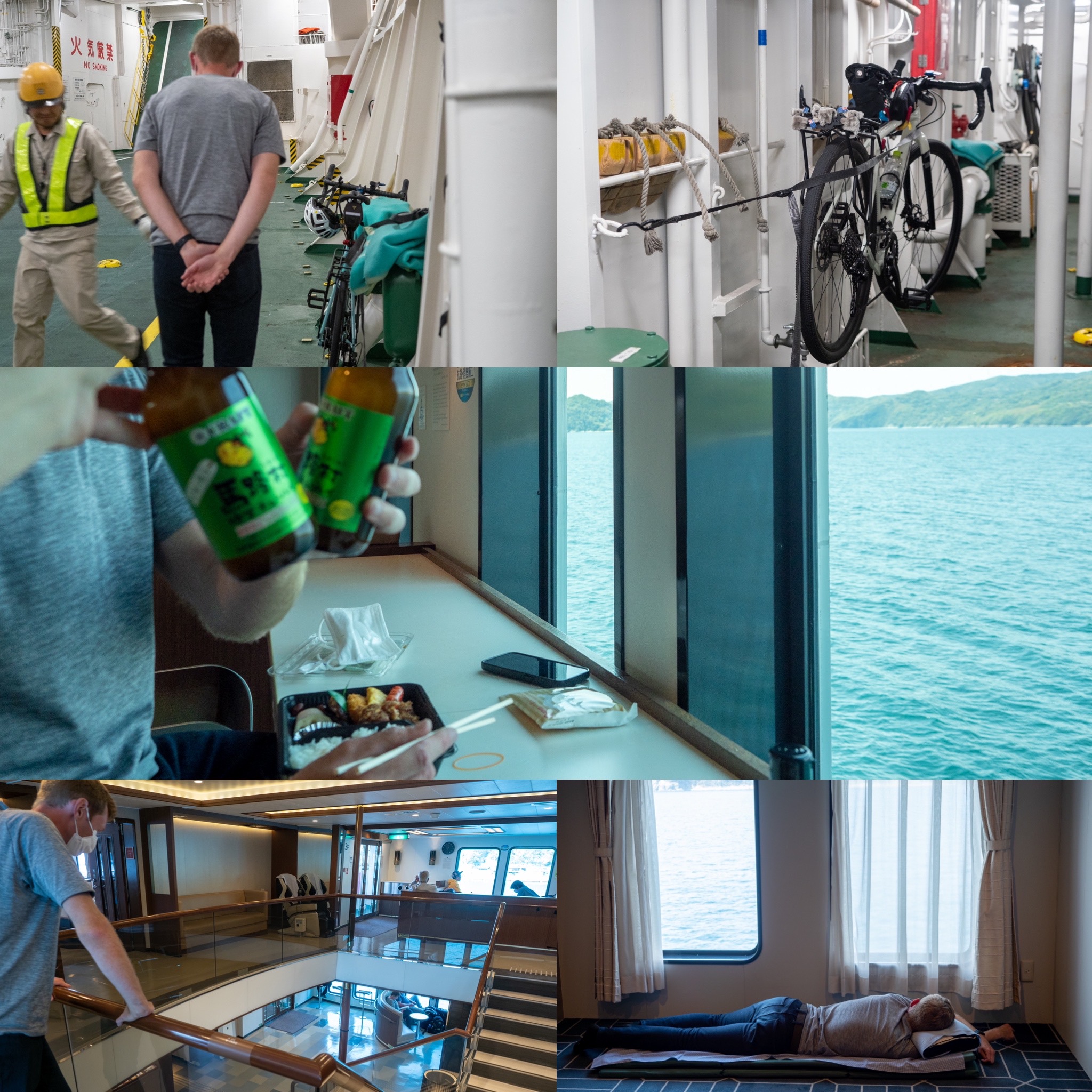
Once on board, we enjoyed a bento box for lunch, with more than one craft cider featuring citrus from the local area. Dunny was exhausted and went to our private room to catch some sleep. I went to the lounge area and caught up on what work I could manage in the short 2 hour trip to Beppu.
What we had waiting for us at beppu was (arguably) our most luxurious accommodation of the trip – an intentionally timed choice to give us our best chance at recovery before what was to come. Hint: mountains, many mountains.
The food here was a sublime Japanese traditional multi-course feast (会席料理). We had a very enthusiastic waiter serving us. I asked him something I’ve always wondered: why the rice always comes last (I like having rice at my side to eat with the rest of the food!). He gave us a 10 minute breakdown of the cultural and traditional meanings behind each course off the top of his head. It was enlightening!
Oh and the reason for the rice coming last? It is called the “shime” (〆) and signals the end of the food – and more importantly drinks.
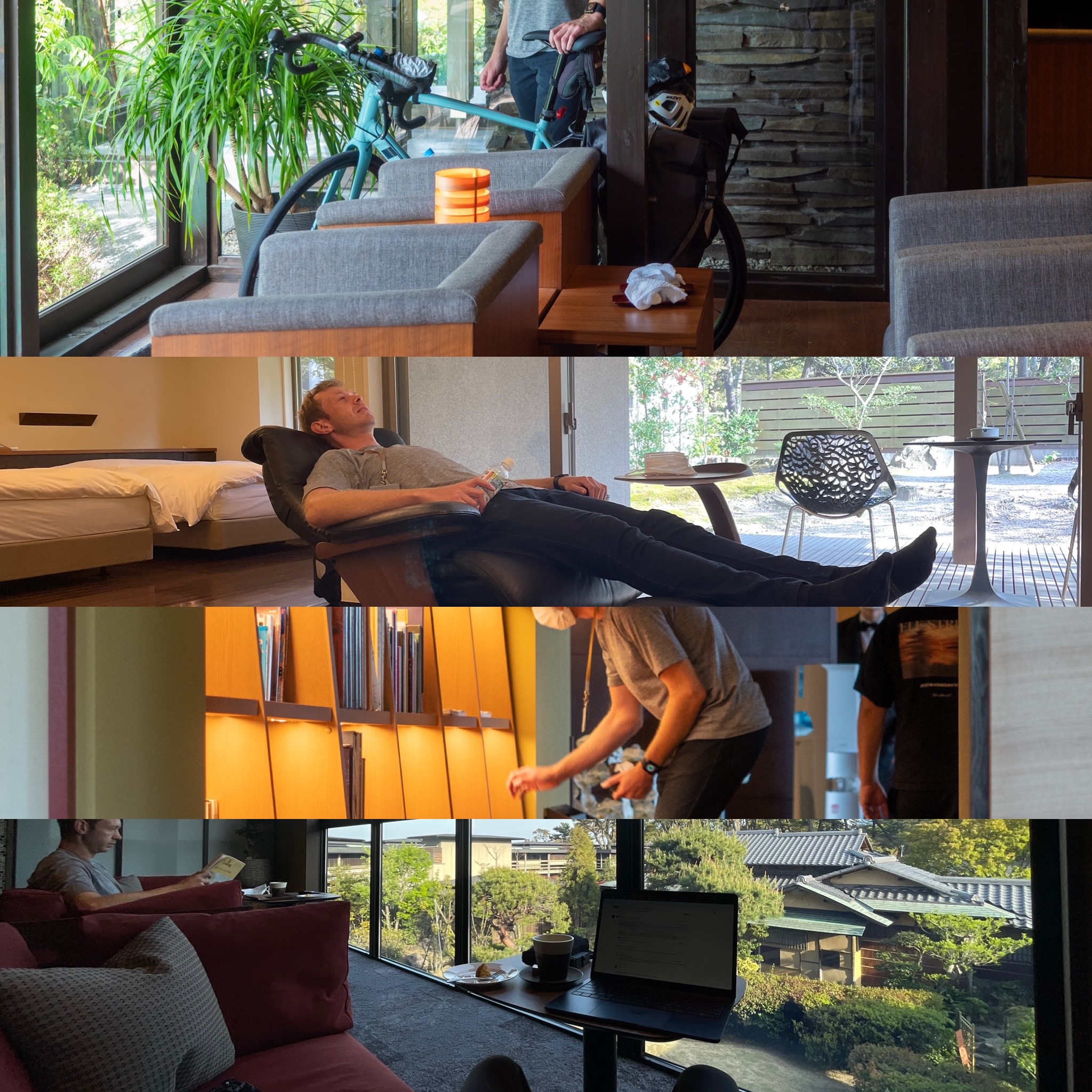
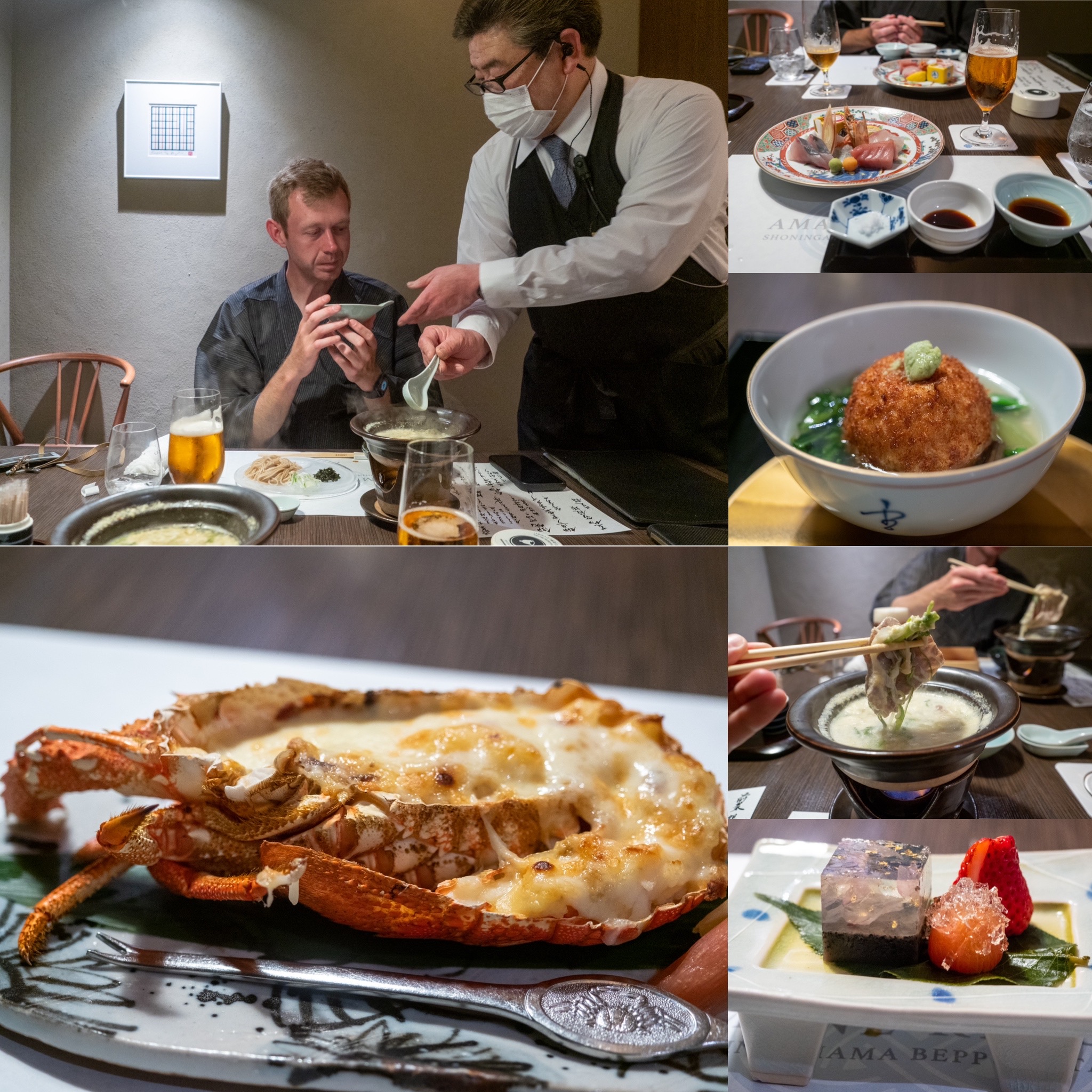
🛌 AMANE RESORT GAHAMA
🍝 AMANE RESORT GAHAMA
Yamanami Highway (やまなみハイウェイ)

We knew ahead of time that this was to be the pinnacle of pain in this trip. So far we were averaging 100-300 metres of elevation change a day, but the first part of this route was to see us climbing 1,450 metres! Our destination was a tiny bed and breakfast hostel run by some of my (not-blood-related) Japanese family. This couple used to run a “rider’s house” – small no-frills accommodation for bikers – but have since moved and now run this cute little accommodation alongside a curry restaurant. I had to visit it, and it was almost precisely on a route!
The day started later than usual as we enjoyed the last of our relaxing stay. We stopped by at a GIANT store on the way out and I picked up some super light gloves. We then set out and were hit immediately with a never-ending slope. The kind of ruthless hills where no end is in sight and all you can do is pedal on.
Early in the climb, we also came across a Montbell store – this area turns out to have some very popular hiking routes as well. I was able to find some really nice arm covers (basically long sleeves without the shirt part for covering from the sun), continuing in our theme of trying to cover more and more of our bodies from the sun. UV during the middle of the day is pretty crazy to the point that even with sunscreen we weren’t feeling safe.
As usual, we exchanged some pleasant small talk with the staff in the store who were very interested to hear about our trip. But it was time to carry on the ascent.
..The hilly terrain just never stopped, and the mountains kept going up as if there was no end. We would turn the next corner and there would be a new mountain to climb right in front of our eyes. We passed a cable car taking people up a good portion of the altitude we were covering, and honestly if they allowed bikes on we may have been tempted to take it!
There was one section where we were speeding downhill around 250 metres after a 900 metre effort uphill. We exchanged some concerned looks and ended up pulling over just to make sure we weren’t going the wrong way and undoing all the work we did! Luckily, it was all part of the route.
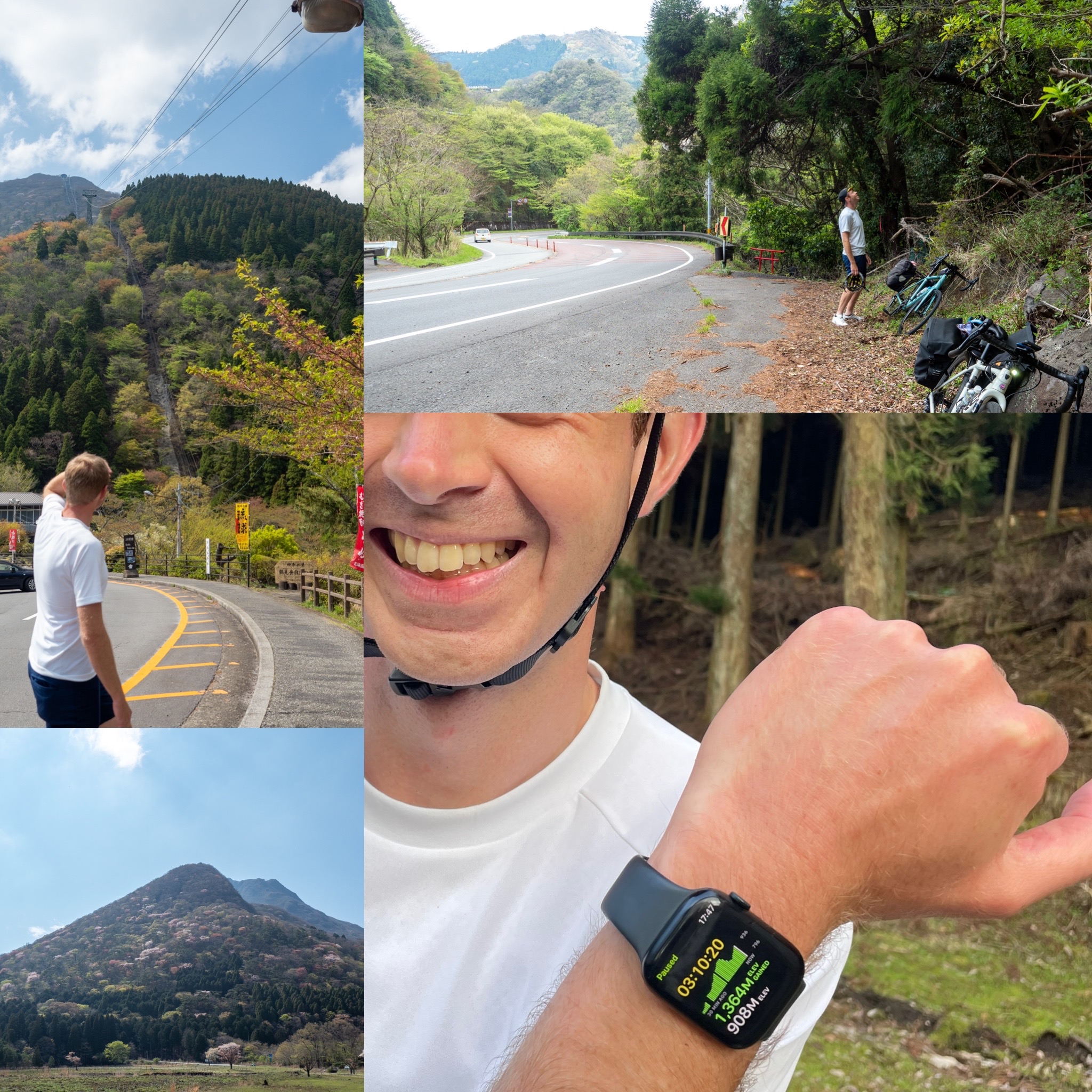
As the sun began to set and we were still quite far from our destination, I made a courtesy phone call letting them know we would be a bit later than expected and were still gruelling away on the road. From the chuckling on the other end of the line, I could tell that I must have conveyed the exhaustion level we were experiencing quite well.
This was one of the first opportunities to use the bluetooth speaker I brought along to jam to some tunes (I was hesitant to use it around civilisation due to noise pollution concerns). It definitely helped keep us energised and motivated to keep on keeping on.
Within kilometres of our destination, we happened upon a small stable with goats and other animals. There was one middle-aged man who ran up to us and we chatted about our trip and about the local area. Friendly locals are always a blast – Japanese country people always seem to be more willing to engage in conversation than in the larger cities. Though I guess that’s likely not a trait specific to Japan but more to do with living out in the country.
Down the final slope, there was a group of school kids on their way home from club activities at the end of the road. They gave us the most welcoming wave and greeting! Another sign that you’re really in the countryside.
The guest house we stayed at would usually house up to 10 people at a time, but since COVID it was only available to a single group at once, rather than being shared accommodation. I don’t think that policy is still in place, but we did have the whole place to ourselves, giving us plenty of space to relax and take in the complete silence, apart from the pitter-patter of rain (which we narrowly missed) and sounds of nature.
Before settling down and getting some well-needed rest, our stomachs needed filling. Our curry was waiting. Call it a biased perception – coming off the tail of likely the most strenuous exercise I’ve done in my life – but this was the best tasting curry I’ve had to date. We ate not just one, but two full servings of curry each (classic Katsu curry and Butter Chicken curry)!
Amazing hospitality and some great conversation. Luckily, the Japanese couple running this place did remember me. (I showed up unannounced after not seeing them for a good 8-10 years, so that was quite a happy and relieving moment).
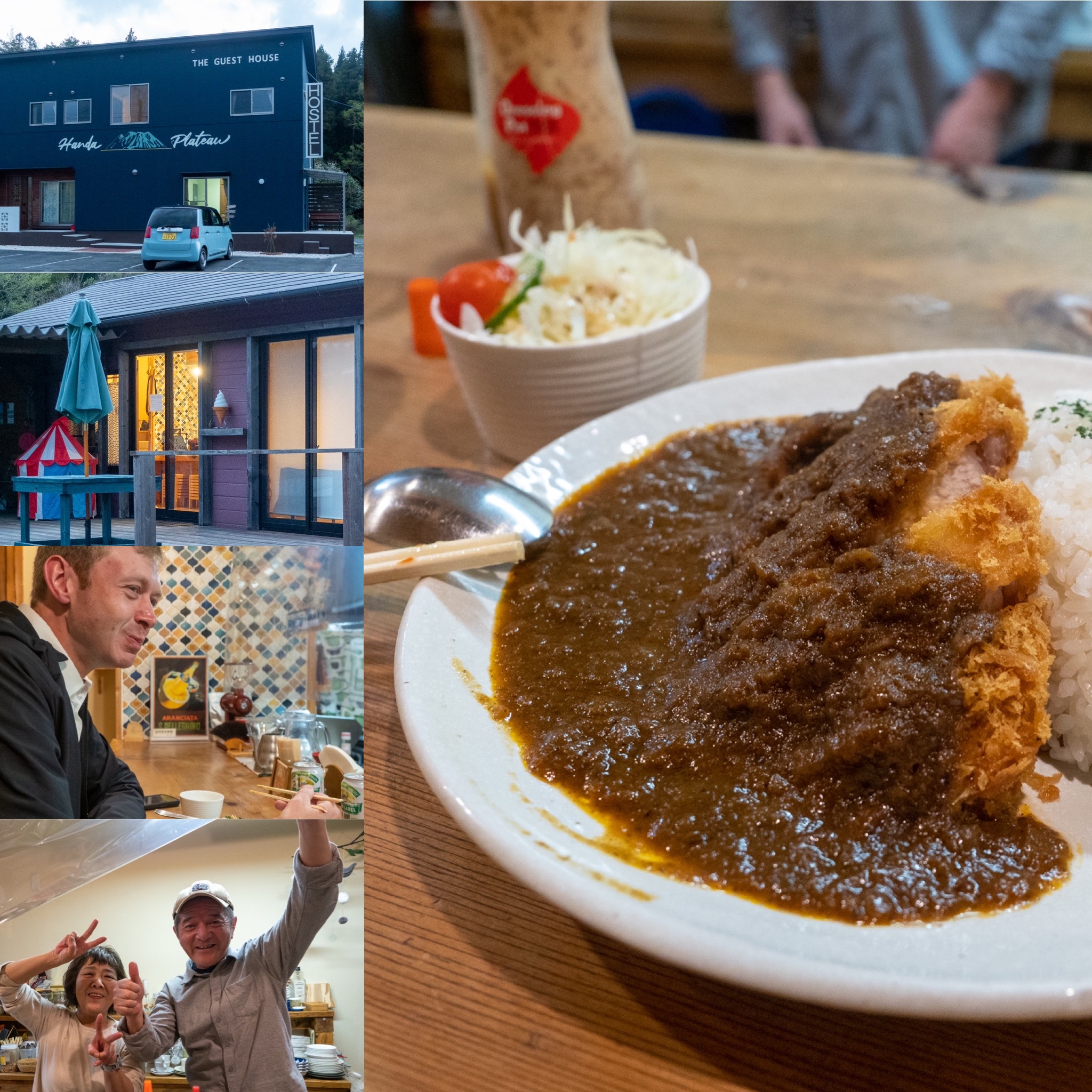
🛌 はんだ高原 ゲストハウス
🍝 Cafe tanetone
This wasn’t the end of our uphill segment, though. Nowhere near as bad as the previous day, but still a challenge. Our goal was the second ryokan of this trip, and awaiting us was a buffet feast. Plenty of motivation to move on.
Starting with the second half of our hill climb from our local peak altitude, we continue forwards along Yamanami Highway, aka Route 11.
The very squiggly portion of road on the map was a rapid descent back down 300 metres of mountainside. Not only was this scary due to the crosswind – almost got blown over at least once – but we also weren’t sure if we were on the correct route. This time it was not really a road we could safely stop on so plowed through with crossed fingers. Luckily all was good, and it was just part of the contour of the area.
Along the way we made a few stops at various roadside attractions, including massive $20+ watermelons, cute cats and a mountain goat getting entangled in its leash. I tried my best to teach the goat how to free itself but goats are apparently not smart.
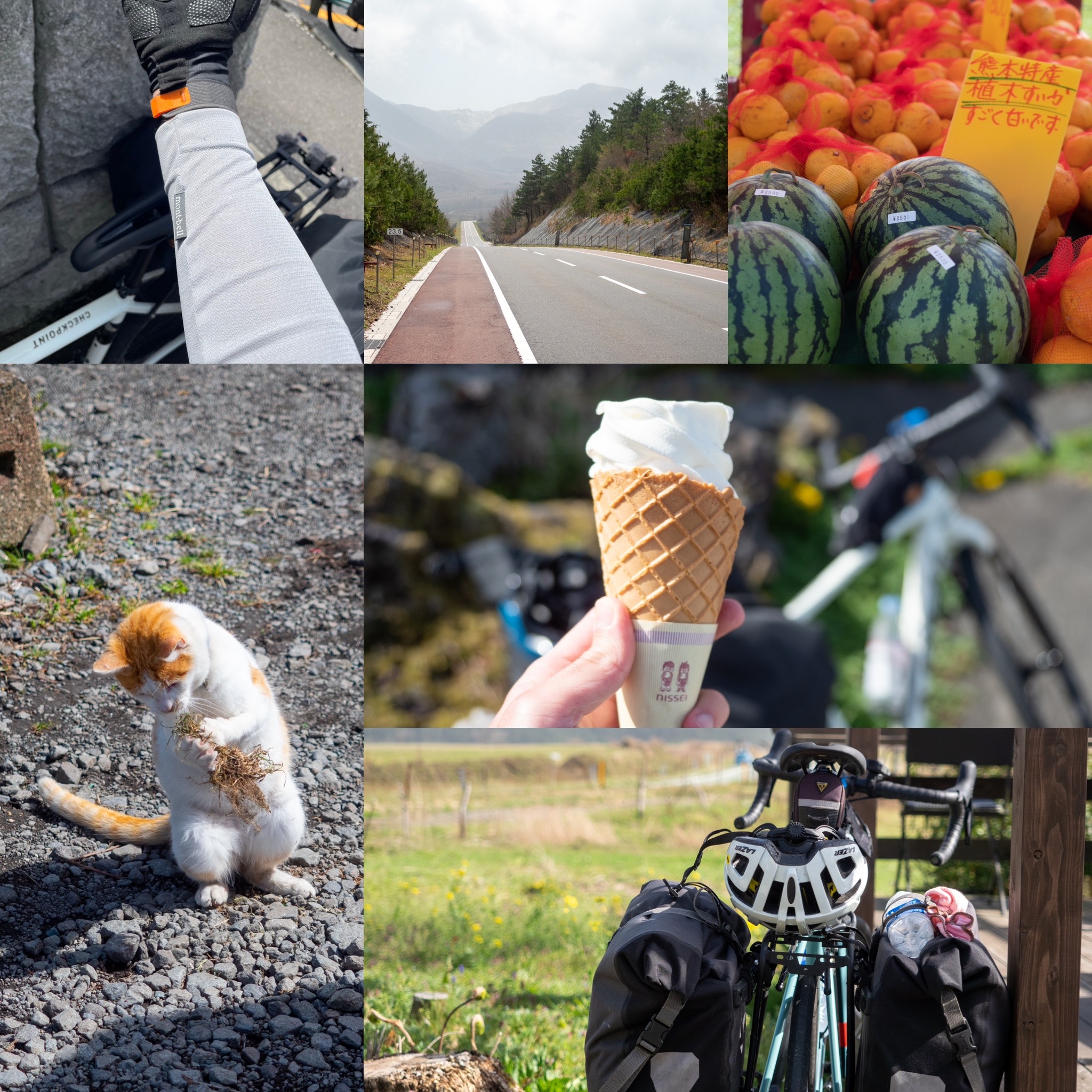
Approaching our accommodation after another long day, our very direct route told us to ride straight through about 2 km of rice fields. This wouldn’t have been too bad, except that due to the recently rain it got very very muddy. But after a day of hill climbing this was quite a welcome change so we embraced it until it got so deep we couldn’t move forward!
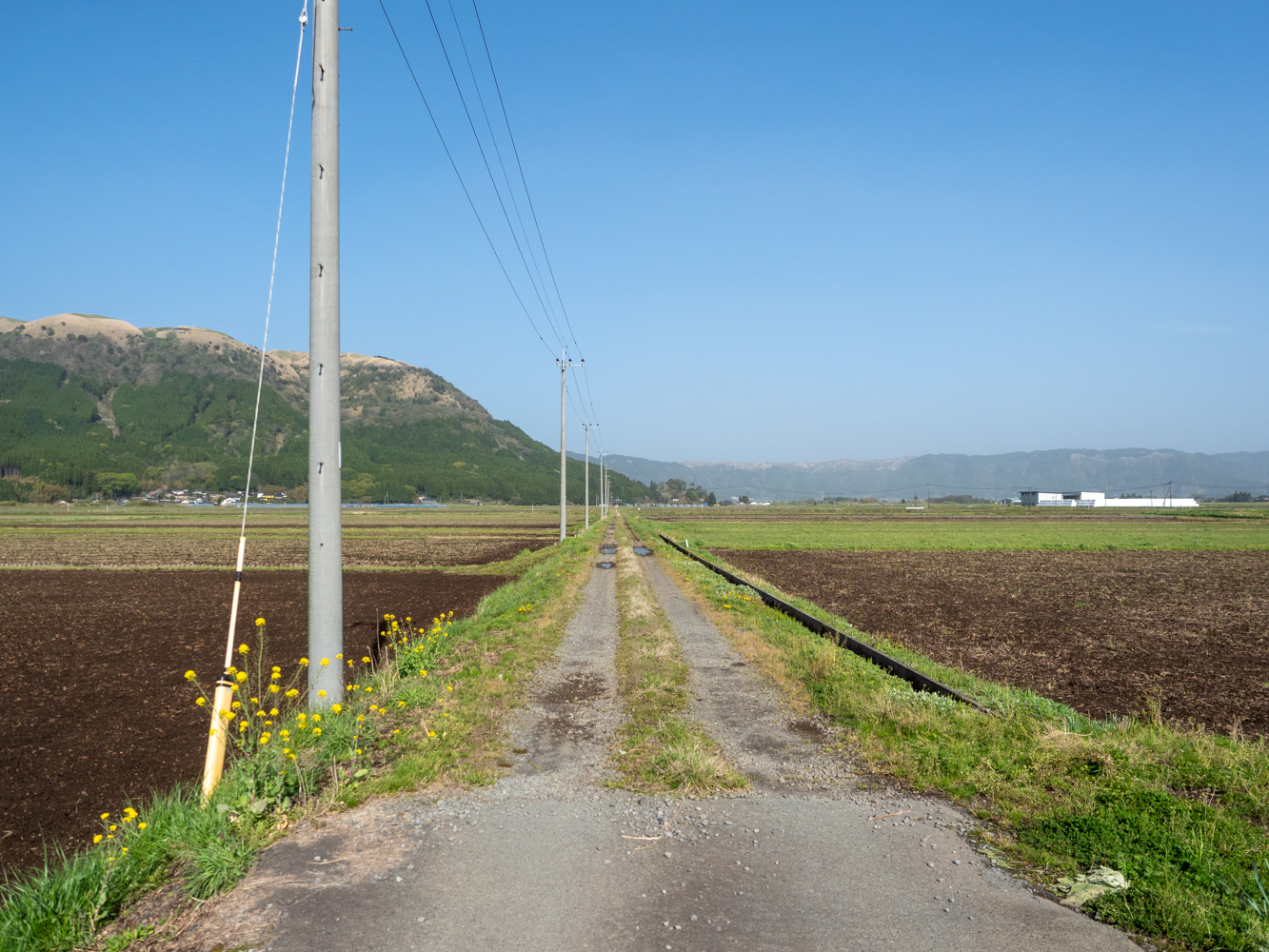
When we arrived at the next accommodation, we asked where we could park our bikes and in a very welcome pattern, after the reception notices we are on road bikes they offered to let us take them to our rooms. Which would have been fine if we didn’t just coat the tyres with fresh layer of mud! We parked outside at a public parking lot next door to save them the clean-up. And enjoyed many beers and buffet Yakiniku.
The next day, as we were already very close by, we set out to visit the peak of an area known as Kusasenri. Kusasenri (草千里) has an amazing panoramic view of the grassy flats around volcanic mountain Aso (阿蘇山).
While we were recovering and taking in the sights, we spotted a pro biking team arriving, who had cycled the whole route that took us one-and-a-half-days to cover in just one morning. It was amusing to see them on super-light bikes with no luggage next to us, with four panniers probably weighing more than all of their bikes put together!
Felt like we were doing something wrong.

Next up was a new single-day distance record, and finally a mostly downhill segment. Our next goal was Kumamoto, to visit a castle and eat some local ramen.
The most memorable part of this day was getting stuck behind some slow traffic during a long mountain descent, next to a small group of bikers (on motorbikes). Since we were all limited to the speed of traffic (still 30km/h or so), we shared the enjoyment of the weaving descent together and had some short exchanges of words while riding. Kind of wish I got some footage from this, but still not at the point I felt confident operating a camera while on this kind of route!
We bid our farewells at the end of the descent as traffic got lighter and we couldn’t keep up with their speed on the flats.
In a continuing pattern, even though the accommodation said they had no bike parking, they accommodated to us and let us store the bikes safely indoors. We were as grateful as ever. They also made us some mean sandwiches for breakfast the next morning.
This stretch was a race against an incoming storm (which spoiler alert: we lost) and also trying to find a route which didn’t take us directly through another mountain range. By this point we were a bit tired and hurting from all the previous days, so even though it was only 40km, it was quite a high effort ride through gloomy weather.
One thing which helped keep our morale high was finding a karaage (fried chicken) shop early in the ride for a very nutritional breakfast, and seeking shelter along the way in some tunnels.

Not too much to say here. Our destination of Kurume was chosen specifically to eat Mohikan Ramen, at Dunny’s recommendation. Too much ramen lately? Nah!
🛌 The Celecton Kurume
🍝 モヒカンらーめん 味壱家 本店
Our final length of the Kyushu journey was to get to our final destination of Fukuoka, where we would take a break for a few days as we visited friends and family. The first time off a bike since the start of the trip.
This day saw us following a major highway, but not one where bicycle were allowed. So we spent a lot of time riding alongside the road, quite often through farmlands, which was a nice change of scenery and pace.
As we approached the city, the weather made a turn for the worst, and we were back on the main road. quite an unpleasant experience as the trucks, passing us at high-speed created their own local weather systems with water, hitting us from every direction!
We were planning to use the opportunity we had during our break at Fukuoka to drop our bikes at the local Trek store for a check-up. This turned out to be quite perfect timing for me, as I got a flat tyre just 3 km before arriving!! I had to pump the tire two or three times to make it there, but we did it.
And then we split ways for a couple of days to take a break and catch up with our friends.
Biwaichi (琵琶湖一周)
After a few days parting our ways and catching up with friends and family in Hakata, we reconvened at Hakata station and bagged our bikes, back on a Shinkanen destined for Hikone (a castle town near Biwa lake).
This was to be our starting point for circling around the lake itself.
As we left the train, we started to assemble our bikes and noticed that we were right next to a bicycle rental store, right in the station. This was road bike rental, too, which make us feel like we were at the right place. Got a few looks (of curiosity?) from the staff as we assembled our bikes right next to the store.
After a short ride from our shinkansen station through light rain, we spent a night at a ryokan overlooking the castle.
The highlight of this ryokan was another guest who we met at the bar area on arriving. He was talking loudly and we were very bemused by his conversation. He was a self-proclaimed regular, and was with a woman who seemed to be a.. relatively new acquaintance. Talking up his connections with the owners, pouring expensive wine from the bottle (it was a very casual BYO bar area).
We went to the conbini and bought some local chuuhai and came back to join them. The guy was actually very friendly, and even poured us some of their wine. We offered them some chuuhai but they were good.
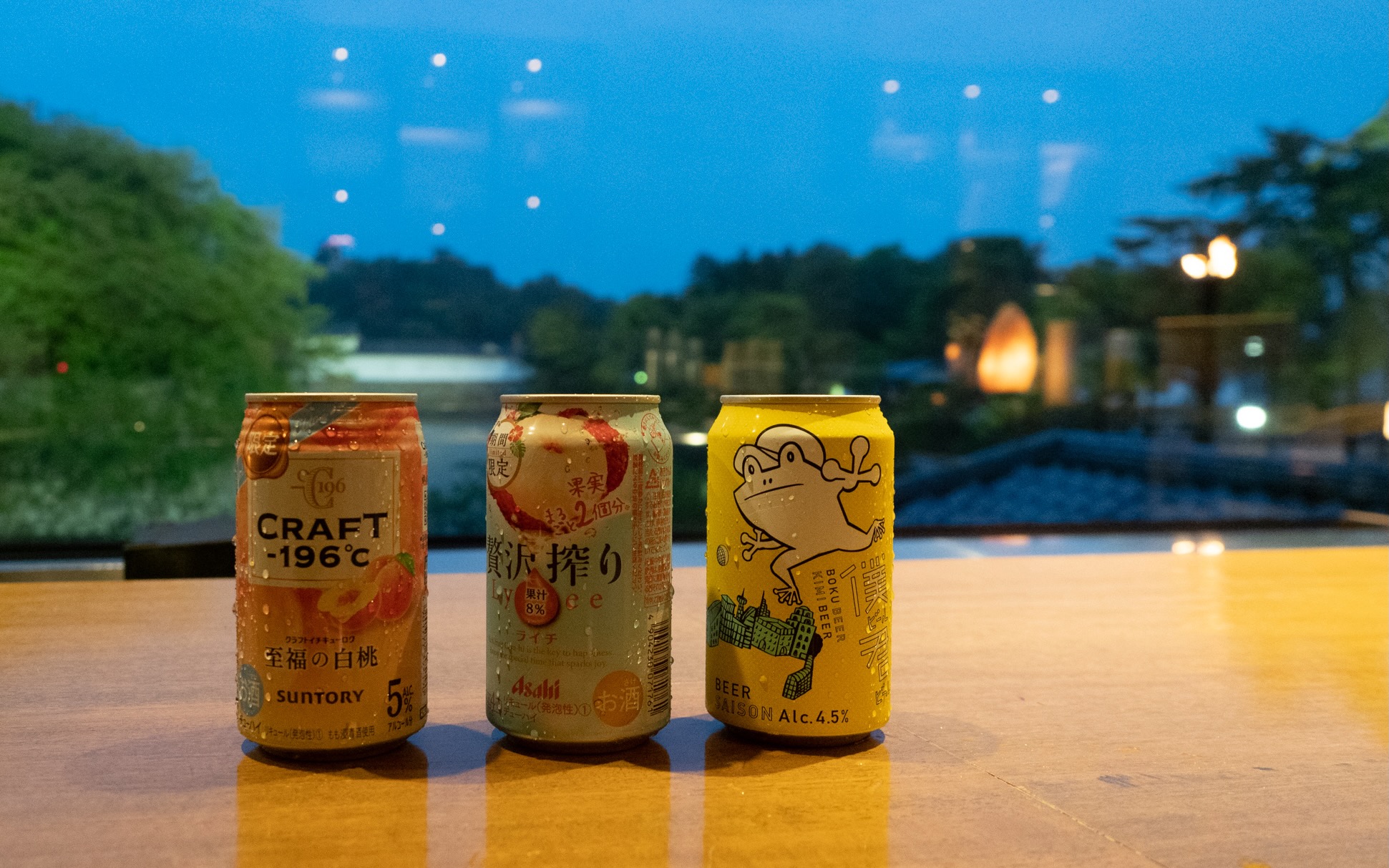
We ate teppanyaki and were lucky enough to be the only people in the restaurant, having the full attention of the chef. He was a very cool guy and very skilled chef. he asked if we wanted to upgrade our rice to garlic rice and there was no way we were saying no!
Still not content with the consumption of alcohol, we decided to make a trek to a conbini. We were already in yukata and wearing wooden sandals. It turned out to be about a 1 km walk. Also, heavy rain started halfway.
I don’t know if it was the sheer absurdity of the situation, the exhaustion from days of riding or the booze, but we were both hysterically laughing the whole way back. We arrived completely drenched, trying to avoid eye contact with the entrance staff while we got back to our rooms and hung absolutely everything up to dry.
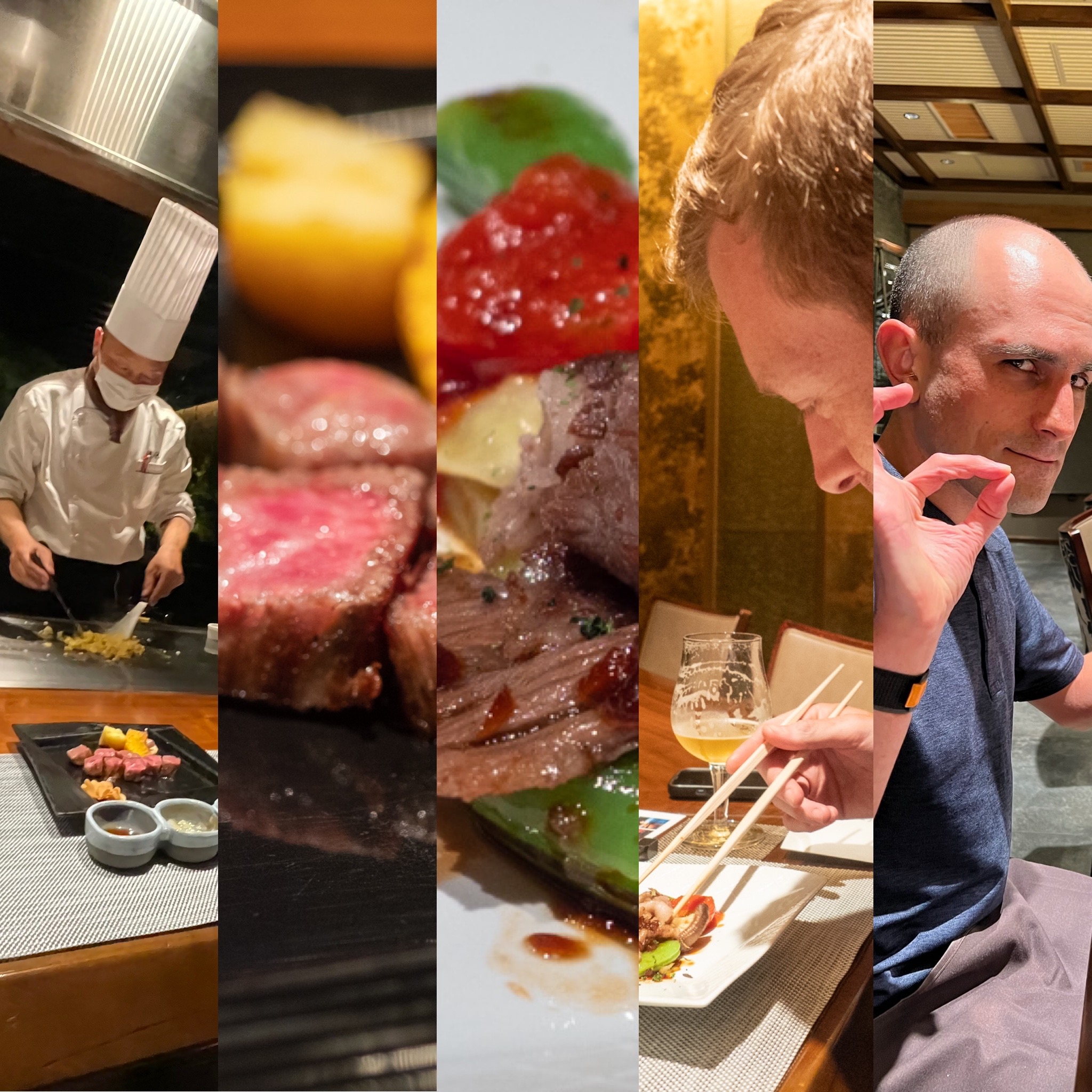
🛌 ホテル 彦根キャッスルリゾート&スパ
🍝 ホテル 彦根キャッスルリゾート&スパ
The next day, we set off early in the morning to make it as far around the lake as we could.
After an initial hiccup where we rode 6 km before realising we were going the wrong way around the lake (spot it on the map), it was smooth progress. Very little elevation change, but a lot of distance.. and bugs to the face.
90 km in one day was a new record for us. My legs definitely felt it. There’s also something to be said about the scenery around the lake changing very slowly, and the fact you can basically see your destination on the other side of the lake (through some very heavy mist!) that made it less of an amazing scenic experience than our previous routes.
Nevertheless it had its great moments. We stopped at a rest house for lunch (and so I could participate in the bi-weekly osu! dev meeting). We also found a little house / shop that was selling craft coffees and ginger biscuits. We bought biscuits intending to take them back as souvenirs for friends but ended up eating a good portion as they were so good!
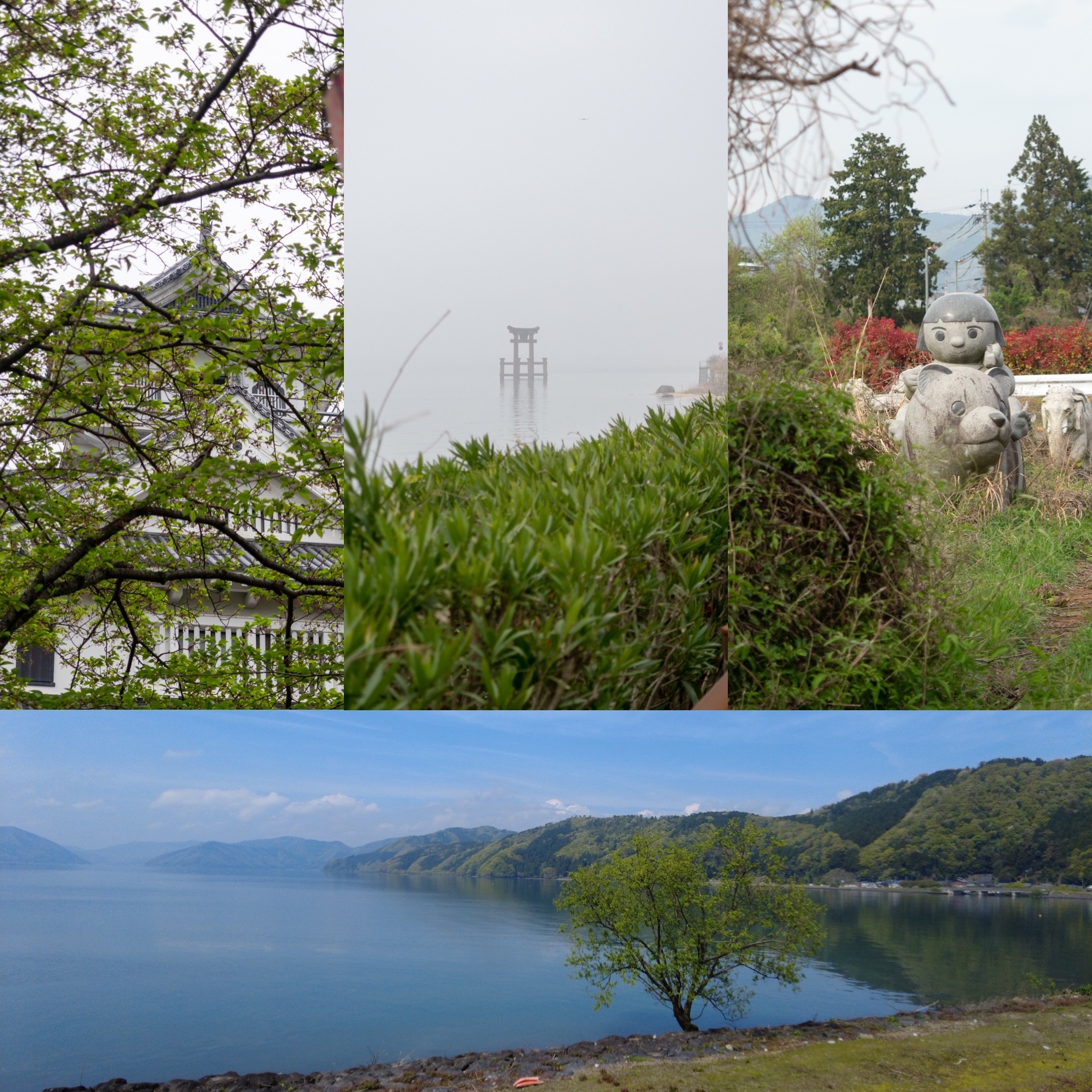
We stayed at a very non-remarkable Japanese inn. What we didn’t realise was that the town we chose to stay at had zero dinner options. It didn’t help that it was a Wednesday which was the day of the week when most restaurants take a break. Literally the most isolated I’ve felt when travelling in Japan to date (there was only one conbini for the whole town!).
We ended up walking 30 minutes to a nearby station and taking a train two stops and finding a Coco Ichibanya curry house to satisfy our spicy curry urges.
The next day was the final portion of the Biwa lap for us. Quite possible the most memorable day: we came across many other road cyclists along the way, but one middle-aged Japanese man in full pink cycling outside was with us for a good 10 minutes. We ended up having a long exchange with him while riding.
Turns out he is a local and rides around the lake almost every day, clocking up over 1,000 km a month. It was really fun to share our experiences with him, and hear how he regularly runs bike tours around the lake showing people around. He even offered to take us to our final destination, somewhat in the opposite direction to where he was travelling, but we politely declined as we wanted to make a stop at a local department store along the way.
He left us with some energy pouches that I don’t think either of us have opened to this day, keeping them as memorabilia of the trip. I wish I thought quick enough to give him one of the koalas that was hitchhiking on my bike in return! We actually tried to find this guy on twitter or similar so we could stay in touch, but unfortunately haven’t had much luck. I guess we’ll need to head back to the lake at some point to find him again. Hopefully he’ll still be wearing pink as to make identifying him easy.
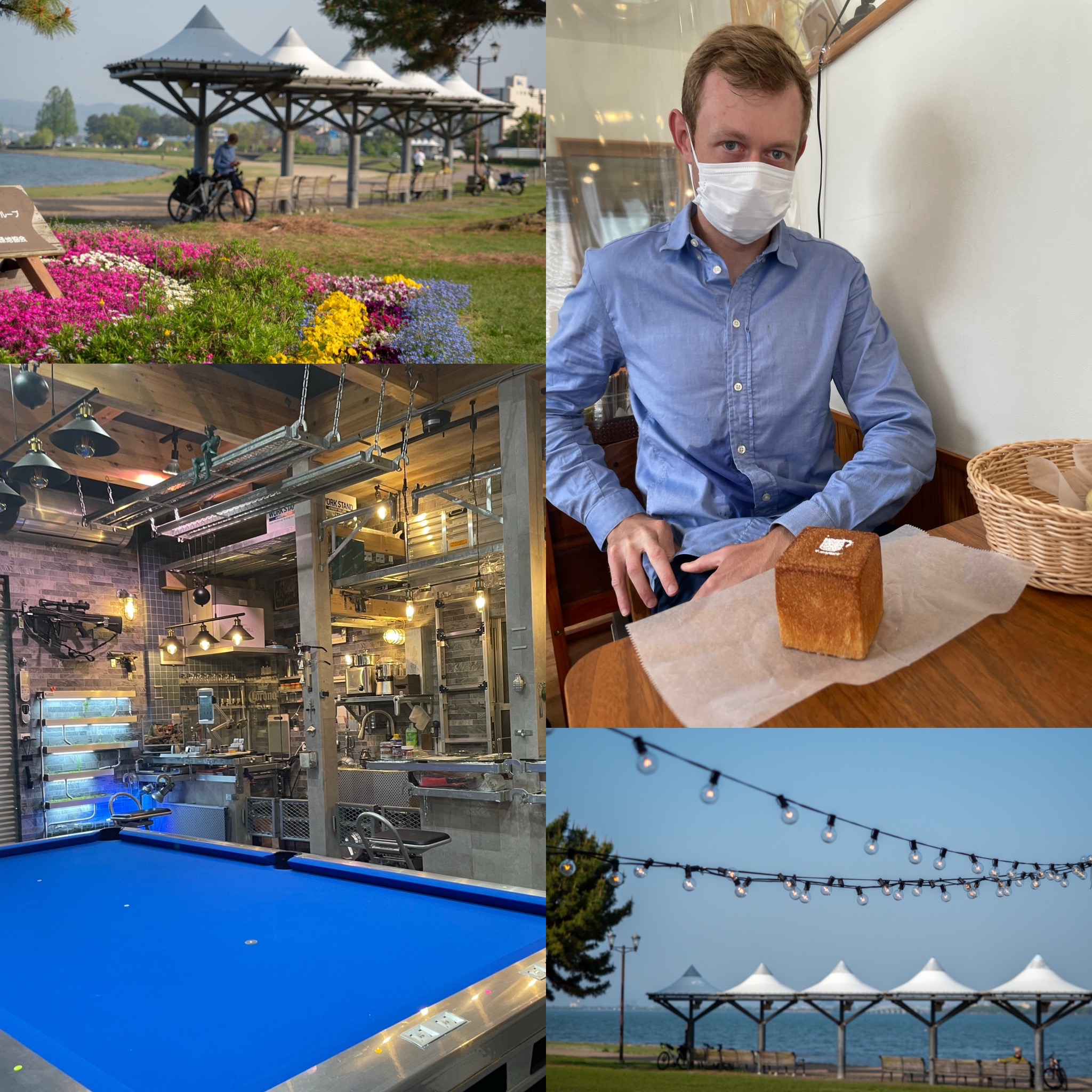
We stayed at a very interesting little guesthouse constructed to make the most of the limited space they had. Each room was crafted to use every last centimetre of available ground and wall space to the fullest. They also had a little cafe and bar on the bottom floor, with hand-crafted miniatures and many a collectibles across such a wide range of hobbies that I was astounded it could be all the doing of the couple running this place.
Our dinner was a very average conveyor belt sushi (回転寿司) experience at Sushiro. Wouldn’t do again, noisy and automated to the point of frustration. Am I the only one that enjoys a bit of human interaction when going out to eat?
To Osaka (京都→大阪)
You may have noticed we didn’t actually do a full rotation of the lake. That’s because we wanted to set ourselves up best we could for the next day, position wise.
One of the auxiliary goals of this trip was to visit Universal Studios Japan for the Super Nintendo World experience. Our original plan was to pack our bikes and use trains for the remaining portion of the trip, but coming this far, we agreed that it was very much preferable to just ride the distance.
This turned out to be a fairly nice ride, following Yodogawa river most of the way between these two cities. Most rivers in Japan have shared pedestrian/cycling paths which meant that finding our way around was quite simple once arriving at the river.
The only thing blocking progress on this day (quite literally) was blockades every few hundred metres on these paths, intended to stop motorcycles and bipeds from using them. Usually, you’d be able to cycle a bike straight through (with a bit of precision), but due to the breadth of our pannier bags this meant lifting our bikes each and every time. I think we counted about 20-30 of these.
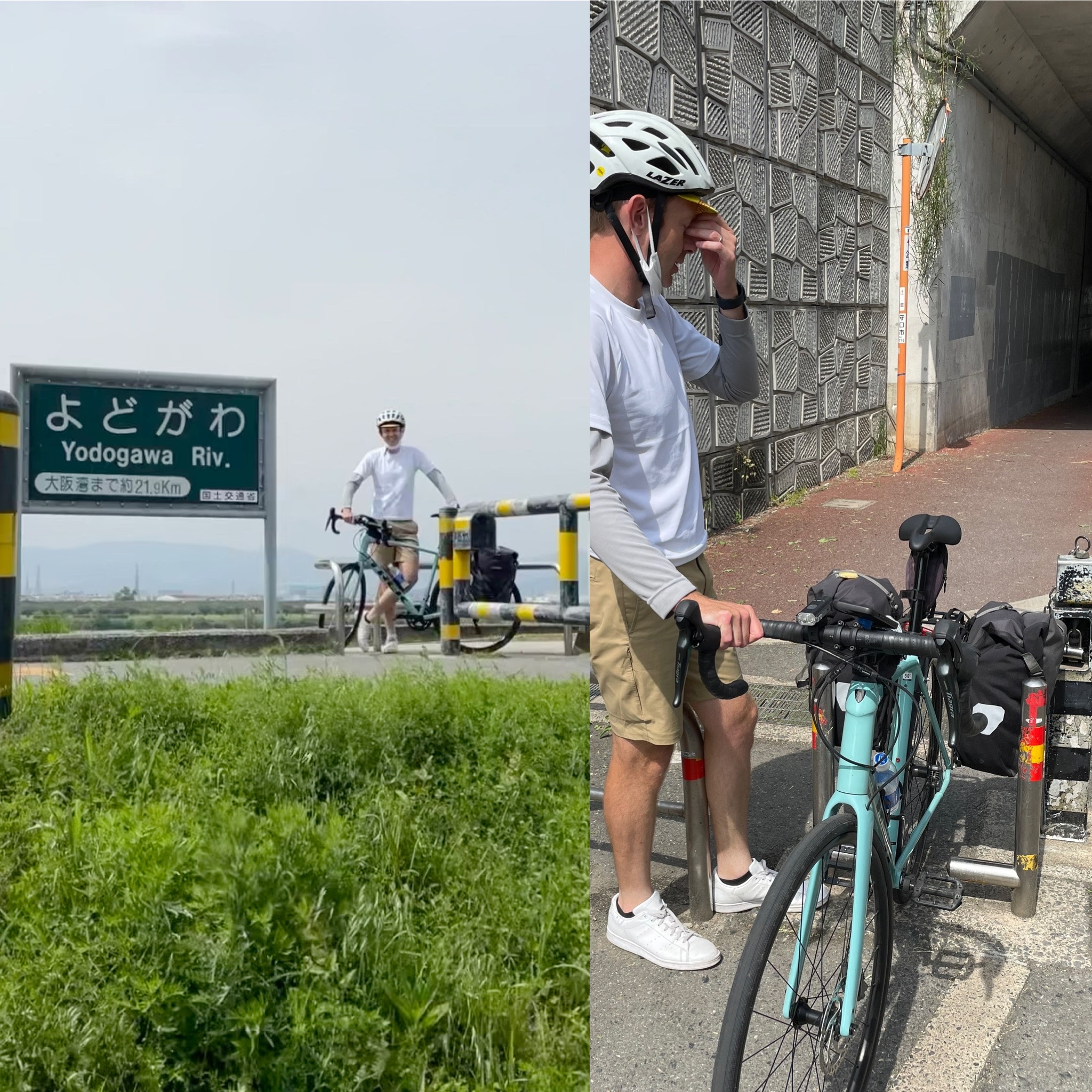
Arriving in Osaka was quite unremarkable. But it was the first time where a hotel was not willing to work with us for bike parking. I had to search around the area for something that would work for us, which happened to be a department store about 10 minutes walk away. Not too bad.
We spent two days and nights in Osaka, checking out the touristy things like Doutonbori (道頓堀, a smoke filled night life district – no thanks!) and eating some amazing street vendor Takoyaki and ice-cream!
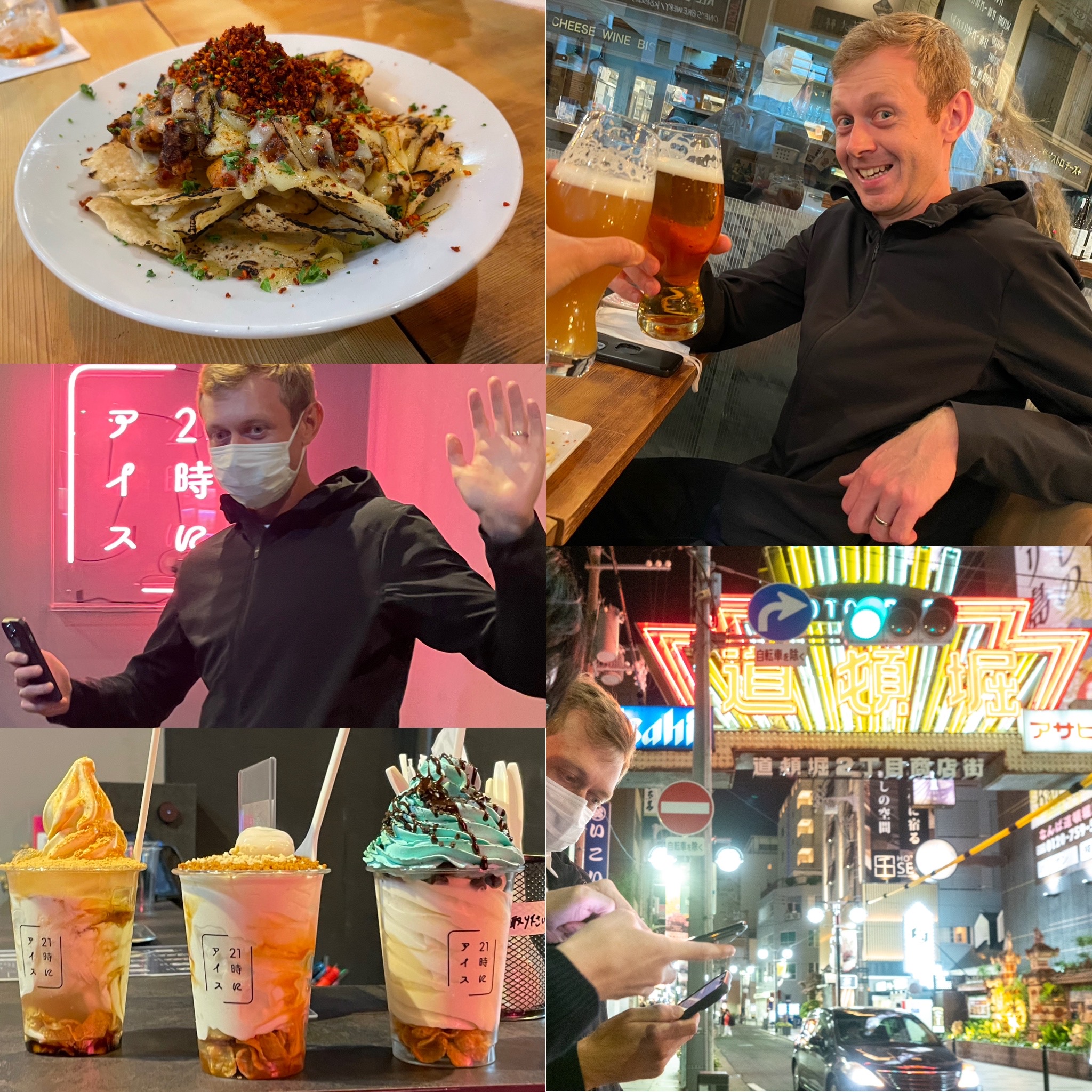
We found a craft beer bar with really welcoming staff and spent both nights drinking all they had to offer, both local and international selections.
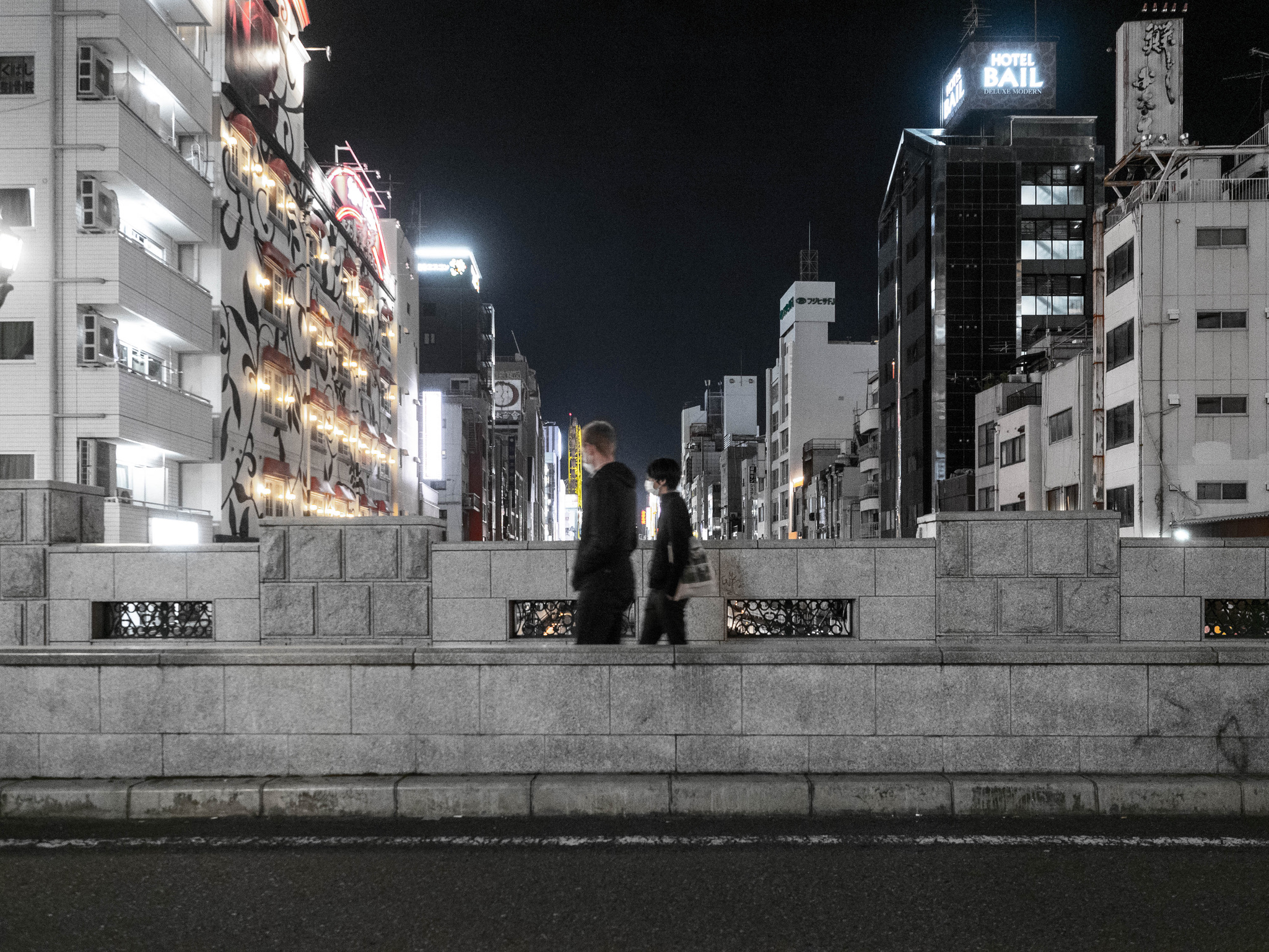
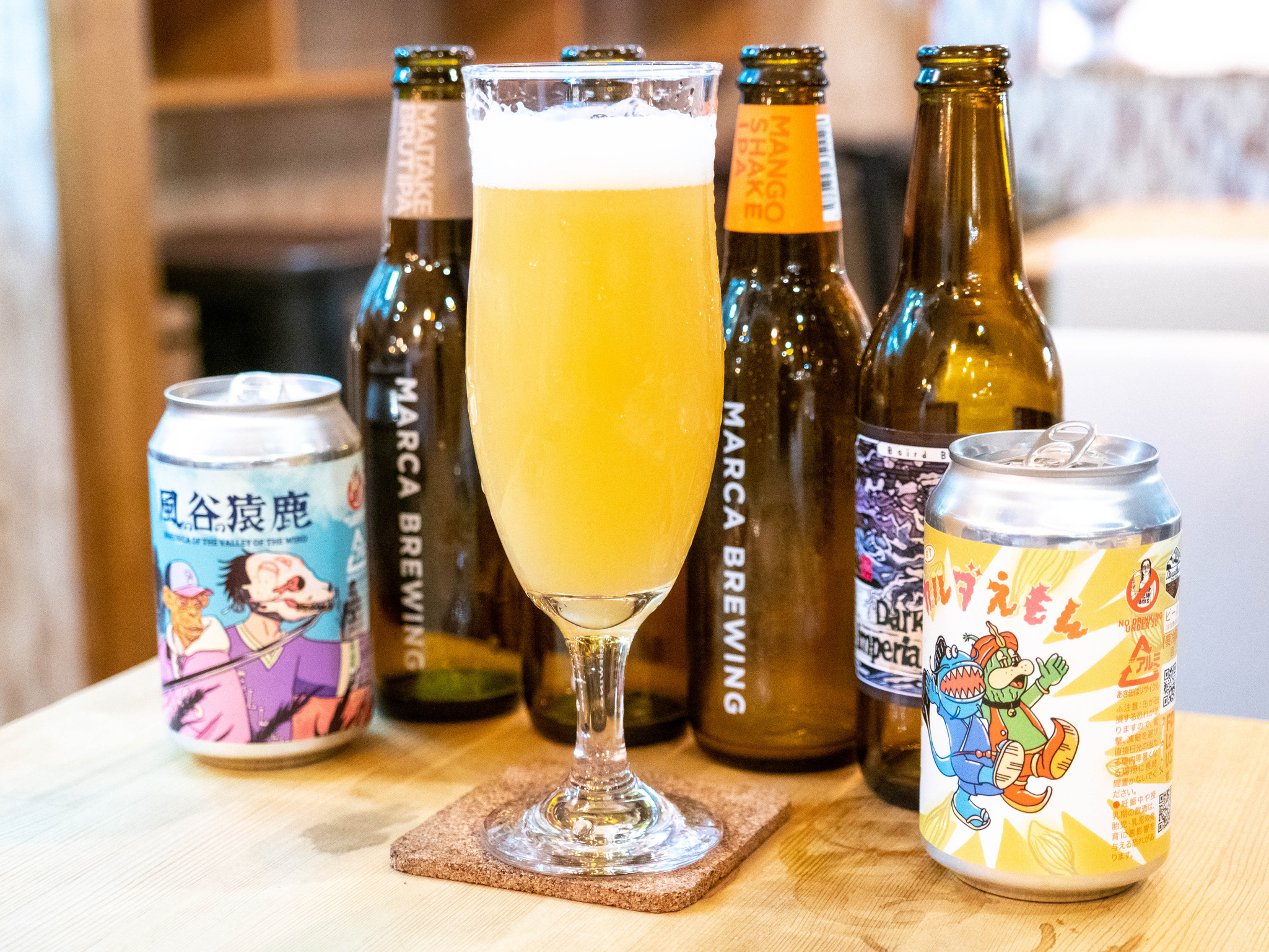

🛌 VIA INN SHINSAIBASHI
🍝 CAFE & LOCAL CRAFT BEER ARCA-ARCHA
Let’s not forget our main goal being to visit Super Nintendo World at Universal Studios, alongside a friend who travelled from Tokyo to meet up with us. We had to buy tickets months ahead of time, but even having tickets, we had to arrive within a 15 minute window and join a massive line to get in to the colourful Mario sub-area.
We witnessed a Japanese family handover two of the tickets to a foreign family that was crying at the entrance, not able to get in as they didn’t realise the area needed a second separate ticket.
I won’t to go into too much detail about super Nintendo world, but it surpassed my expectations in many ways. The soundtrack was definitely the highlight for me, with original compositions and arrangements of existing Mario music renditioned to suit the theme park. As you walked around, a single track would seamlessly transition into different versions, it was just so well thought out!
We ended up, glitching out the star system and getting into the final Boss battle room while skipping one or two mini games. Which was great because each mini-game had a 20-40 minutes waiting time in line.
The only real drag was the amount of lining up to get anywhere.

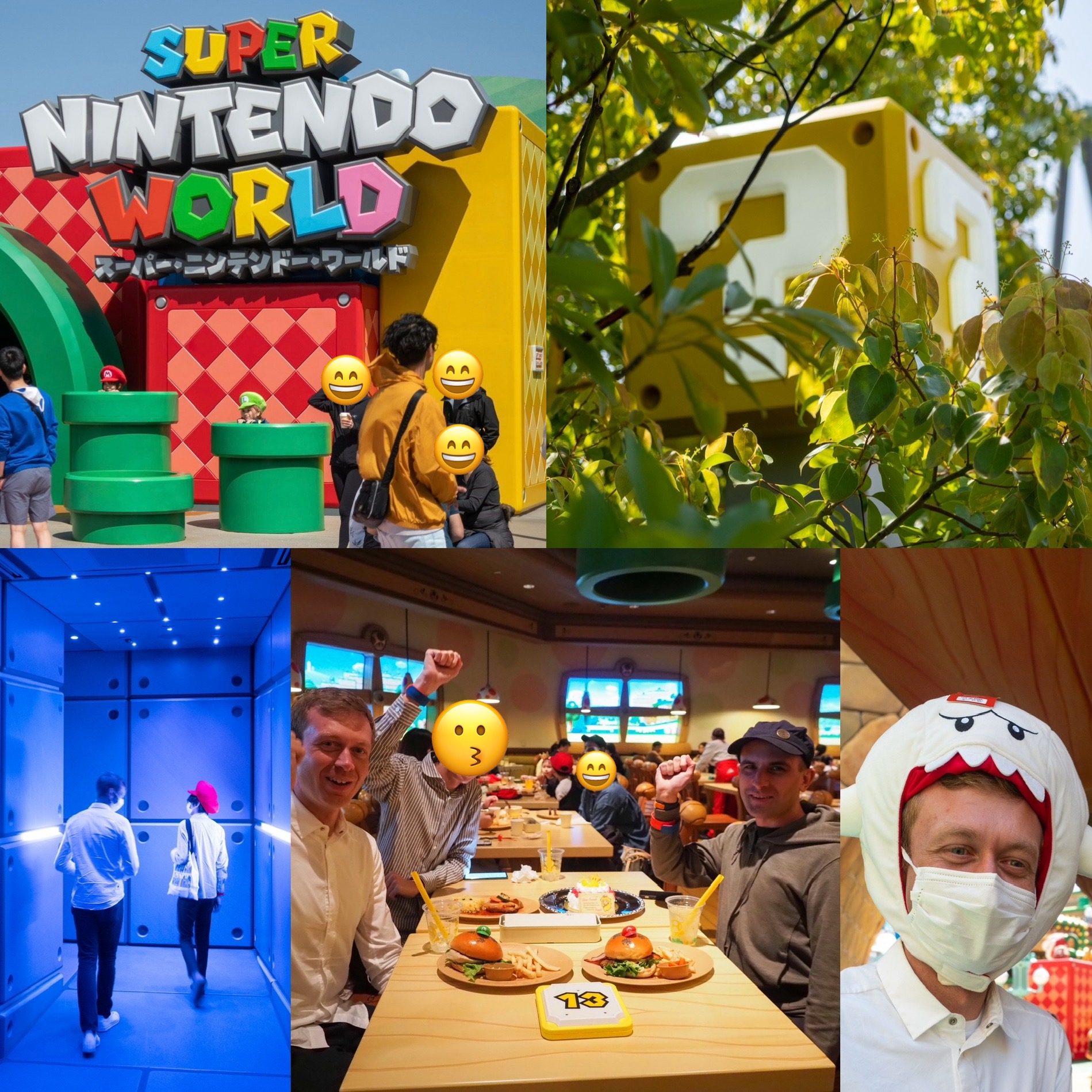
To Himeji (大阪→姫路)
This was a bit of a bonus round. The original plan was to catch a train but after the previous efforts, we were much more confident at this stage we could make a final 110km push and avoid the hassle of bicycle disassembly.
Getting out of Osaka was a bit of a pain, but once we reached the coast this became an amazing route. We followed a main road for a good portion and stopped for lunch (and beer) in Kobe.
Continuing on, we took an amazing shared pedestrian/cycling path for a good 10 km, with coastal views the whole way and not a single car in sight. A very welcome change!
The last segment saw us following the Shinkansen tracks while taking on some very strong head winds.
Pushing through on our longest ride yet, we made it to Himeji just after dark, quite worn out. It was an unexpected surprise to see a welcoming party, waiting outside for our arrival! Very heart-warming!
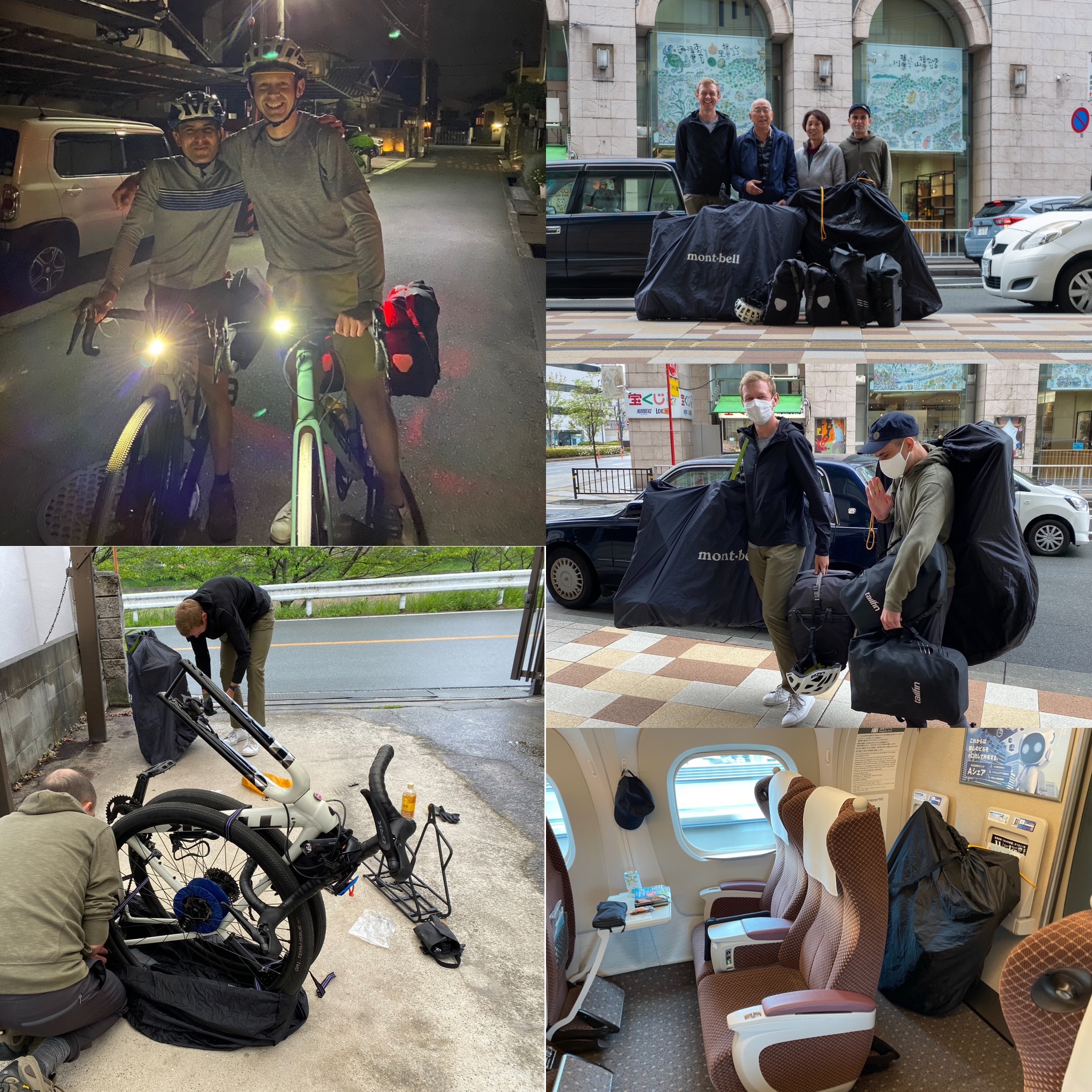
And that’s a wrap!
All in all, we ended up covering a good portion of western and southern Japan. Would have loved to fill in the gaps, but we were already pushing both our fitness limits and time constraints! I actually needed a couple of months to recover from knee pain that was building up (apparently quite a common thing amongst cyclists when you go beyond your limits).
If you’re interested in diving deep into the routes we took, along with our speed and (my) heart rate, you can find the raw data here!
Oh, and this wasn’t actually the end of our cycling team. When we got back to Tokyo, we still felt like a final ride before parting ways, and did a 105 km trip up (and back down) Tama river (多摩川) to feast on some burgers. This set a record for a single day on this trip, and was a really nice way to end things!
As an aside, I was really happy to have as much footage and GPS data of this trip, and enjoyed the process of creating this article (along with figuring out the best way to visualise things). While I ended up using Relive – and app that does most of the heavy lifting – I tried out five other methods of visualisation, all which had their individual benefits and drawbacks. Here’s just one example I was toying with, which feels really nice and correctly shows the break stops we made along the way, but ultimately didn’t convey the scale that 3D visualisation can.
Society, technology and everything around us is changing faster than ever. A lot of the social discourse and news that is propagated these days is negative, uncomfortable and sometimes just outright scary. You may call it coping, but I make the personal choice not to follow world events and stay as uninformed as possible. It keeps me sane.
Call it luck or call it genes, I’ve never felt anything like burnout, stress or depression. With that said, during covid due to lack of social interactions I optimised my life to allow me to be the most efficient developer I could be. My productivity sky-rocketed, but in that time my fitness dropped significantly, and while I was still very happy, life became a touch mundane.
This cycling journey allowed me to observe and interact with people in smaller towns and of differing cultures and lifestyles, living with completely different perspectives and outlooks on life to your own. It felt refreshing and to an extent, opened my eyes to facets of life that I may be missing out on with laser-focused productivity goals.
Interacting with people and experiencing what nature has to offer is invigorating. Pushing yourself beyond the limits you thought your body had is painful but rewarding. If you’re not in the best place mentally – or even if you are but just need a change in pace – maybe it’s time to do something crazy like cycling in one direction as far as you can. It might help set you straight just a bit.
Oh, were you expecting an update on osu! development? I’m sorry to disappoint. The ongoing development on lazer is going great, although we’ve had setbacks with both available developers and dealing with the insanely complex requirements of each and every user.
In hindsight, trying to address almost every problem users had brought up in the last decade all at once wasn’t a good goalpost to set. And maybe the yearn to keep all game and scoring history intact and roughly balanced with a newer system is a stupid waste of time. But I will continue plodding along in a forward direction that I hope will end in something that old and new players can respect.
If you want to know more about the development process, we’ve basically shifted to a video changelog style, with around two update videos a month. It’s really fun and probably easier to digest than text anyway!
Until next time!














